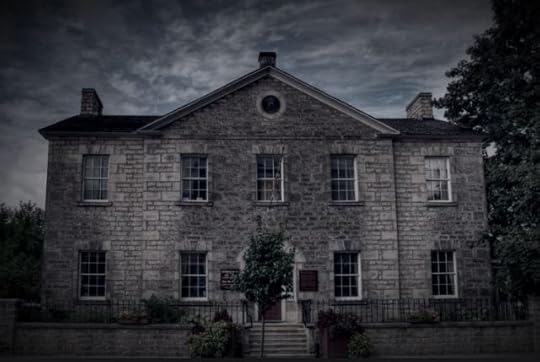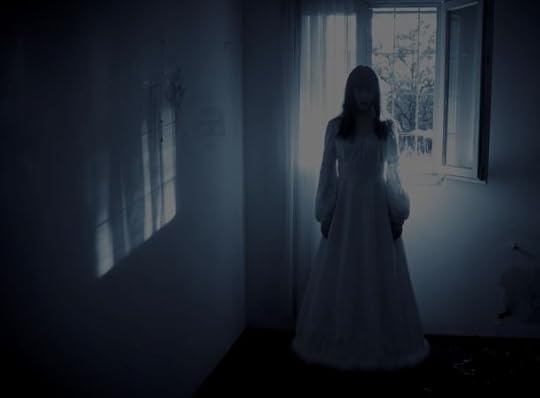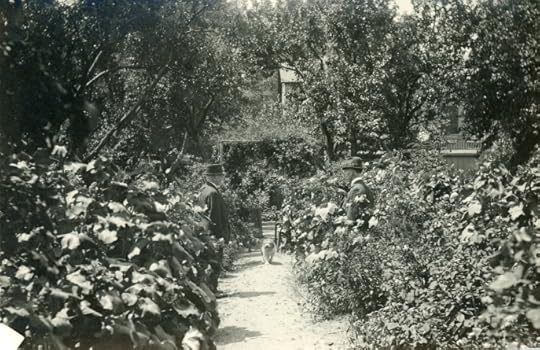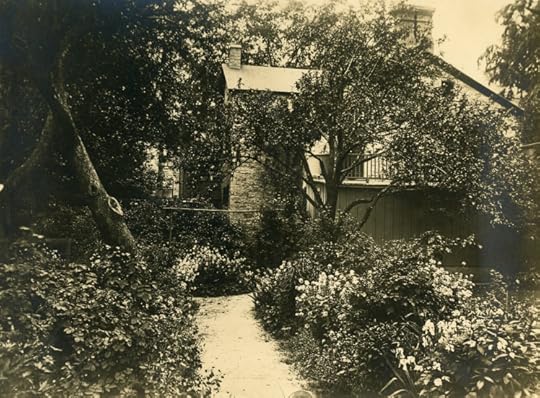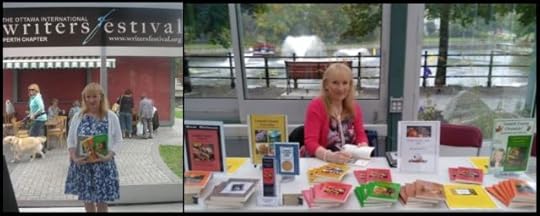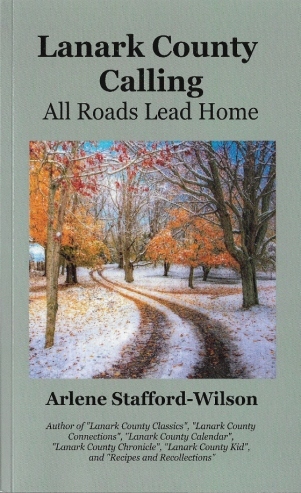Arlene Stafford-Wilson's Blog, page 16
October 12, 2023
Balderson’s Grisly Murders
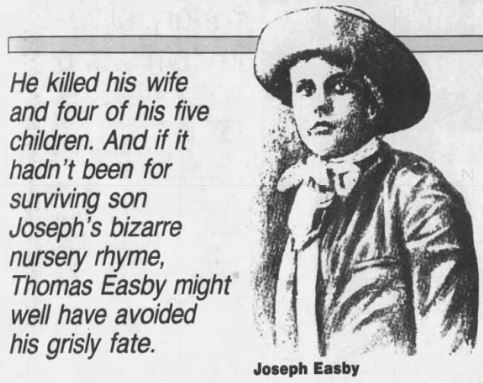
December 10, 1828
near Balderson, Ontario
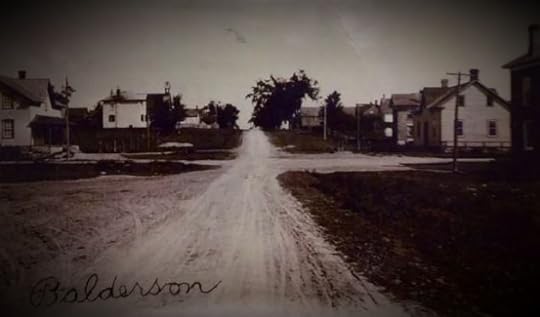
On a cold, dark, December night, right around midnight, Sinclair Tullis’ mother woke to a blood-curdling scream coming from the direction of their neighbour, Thomas Easby’s house. She sent her son to investigate and he could see that the Easby home was engulfed in flames, and heard his neighbour’s voice call out, “Who is there?”

Tullis asked him what happened, and Easby replied, “Go home. The fire is under control. I will be awake until morning.”
When Tullis returned the next morning Easby told him that all of his family had burned to death except his youngest son, Joseph, who sat quietly on the ground, not far from his father. Thomas’ wife, who was eight months pregnant, their daughter, and three sons, were all dead.

Mrs. Martha Richardson, a neighbour, volunteered to look after young Joseph Easby, age four, and although, understandably he was still in shock, she found that he was doing some very odd things. He often sang morbid songs while he was playing, “Father killed mother, sister, and three brothers.” Mrs. Richardson found these songs quite disturbing, as well as some of the games he played. Sometimes he would point to the handle of their shovel and claim that his father had struck his mother with one just like it. He also played a game where he pretended to cover his dead siblings with hot coals.
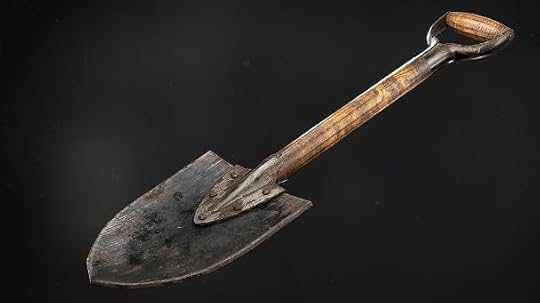
After a few weeks, when Christmas had past, and young Joseph continued to play the strange games, and sing the shocking songs, she informed her neighbour, Sergeant John Balderson, a former infantry soldier. He began to make inquiries and spoke with some of the legal officials in Perth about the young lad’s odd behaviour.
In February two magistrates, along with Dr. James Wilson and Coroner William Matheson went to speak with Thomas Easby and grew suspicious after he gave them his explanation of what happened that fateful night. They ordered an exhumation of Easby’s wife and children, and an examination was done by Dr. Wilson, who determined that Mrs. Easby’s skull was fractured in five places, and the children’s skulls also showed signs of blunt-force trauma. Easby could not explain how these injuries happened.

The following day, John Balderson, Dr. Wilson, and the local Jailer, James Young, told Easby that his family had been murdered. Easby began to cry, and said that he’d killed them all with a thick branch from a Birch tree. He insisted that he had only intended to kill his youngest child, Joseph, but that the child had looked up at him and smiled, and so he killed all of the others instead.
The Trial
At his murder trial, Easby addressed the court, “I was in a perplexed and insensible state of mind at the time of the murder and had only a faint recollection of what occurred. I seemed to have no power of myself, no volition of my own. But, I was impelled to the act by some mysterious agency, which entered my abode and appeared to assist me. After the dreadful tragedy I called some of my family by name, and discovered what I had done, and I exclaimed to myself, “Oh! My God, I have murdered them.”
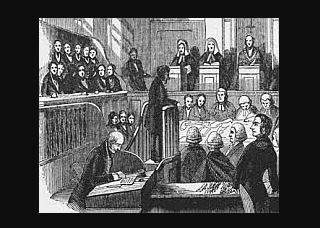
The trial judge, Chief Justice Sherwood, after pronouncing Easby guilty, declared, “Your days are numbered, your mortal course is finished.”
Easby was hanged on November 13, 1829, before the largest crowd ever gathered in Perth, Ontario. Local newspapers praised the skill of the hangman in his execution of the guilty man.

Easby’s body was buried in the Anglican section of the Craig St. cemetery, but later that same night, his remains were exhumed and delivered to the local surgeon and his medical students for the purpose of dissection. According to “The Perth Courier”, “They first skinned the body, and the hide was rolled in salt and afterwards tanned in a local tannery and cut up into small squares, which were sold to the public, bringing as much as two dollars.”
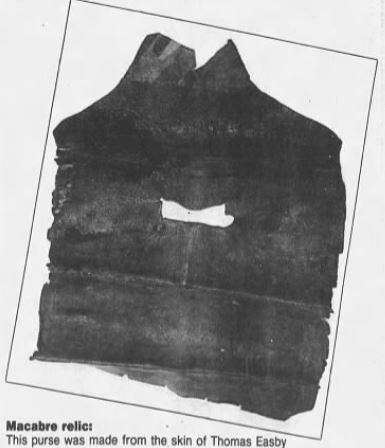
In the 1980s, a reporter from “The Perth Courier”, Michael Taylor, decided to search the area for anyone who might still be in possession of Easby’s skin. Eventually, he located Mrs. George Smith, of Balderson. She had made a purse from Easby’s hide. Another area resident, Alex Balderson, had a strip of the ‘Easby leather’, and had made it into a bookmark. He claimed that it was kept in an old family bible. In faded ink, on the back of the bookmark there was a quote from the Bible, “Whoever strikes a man so that he dies shall be put to death.”
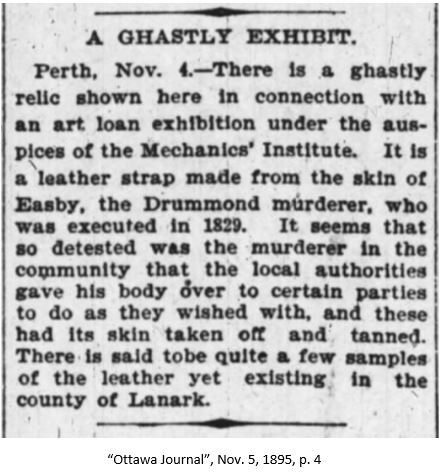
Hide was Sold
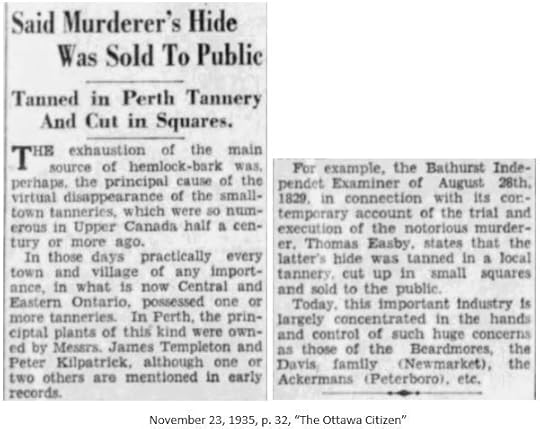
Jail Employees Recall
Stories of Easby
It’s been said that of all the convicted criminals who were hanged in Perth, Thomas Easby was perhaps the most notorious. When it was announced in the summer of 1994 that the Perth jail was closing, “The Ottawa Citizen” sent a reporter, and the employees recalled hearing the stories of Easby’s hanging.

According to one of the workers at the Perth jail, “He (Easby) was kept in the original Perth Jail for several months before he was publicly hanged, the rope adjusted with great dexterity in front of a huge crowd of townspeople. Then his body was dug up, skinned, and tanned, and the bits were sold off and made into wallets and knick-knacks.
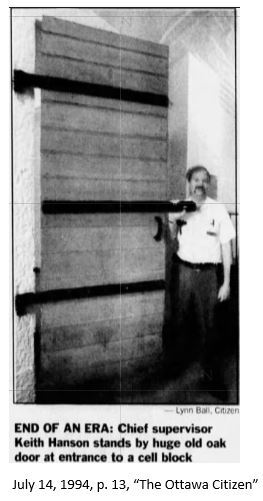
Chuck Stewart, the Superintendent, said that many more people were hanged over the years in Perth, and that the last hanging was in 1910, at the permanent gallows, at the back of the jail. The noose hook has since been covered by a light fixture, and the lever which activated the trap door in the floor has been removed. In its place is a chair on the wooden floor overlooking the exercise yard.
“Murder, as foul as it comes.”
When asked about the future of the jail, Stewart said the cells and prisoners’ areas are tiny and the plumbing and electrical systems are a nightmare. There are rumours of turning it into a bed and breakfast, but according to Stewart, “Bed and breakfast people don’t like sleeping in cells.” Ottawa Citizen Reporter, Kelly Egan, added, “…and who would rest easy on the ground where Thomas Jeremiah Easby met his gruesome end, for murder as foul as it comes.”
What Became of
Little Joseph Easby?
And what became of young Joseph Easby, orphaned at the age of 4, and the only surviving member of his family? In a letter dated in 1857, regarding the estate of Joseph Easby, he had drowned at age 32, unmarried, after falling from a ship in the Toronto harbour.

In the small community of people who lived around Balderson, the story of the tragedy that took place at the Easby farm was told and re-told down through the generations; and although they are fewer in number these days, some still claim to possess items fashioned from the hide of Thomas Easby.
Anyone who has visited the pretty hamlet of Balderson, and knows their long history and stellar reputation for cheese-making, would no doubt be surprised to learn of the gruesome and grisly events that took place at the Easby house, on that dark, cold, winter’s night in 1828.
Further reading: A book was published in 1903, written by Robert L. Richardson, the grandson of Martha and Thomas Richardson, who cared for little Joseph Easby, until he was adopted and raised by a couple in Toronto. His book, “Colin of the Ninth Concession”, was loosely based on the Easby murders.
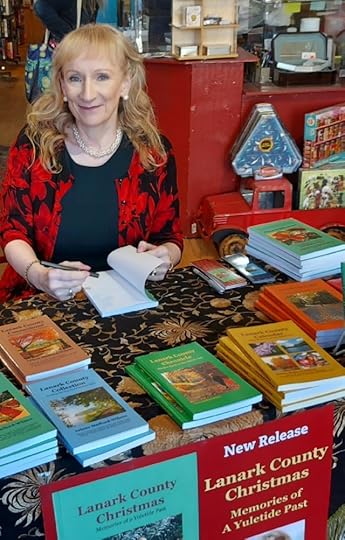
Arlene Stafford-Wilson
Honorary Life Member, Lanark County Genealogical Society
Member, Association of Professional Genealogists
Author of: “Lanark County Kitchen”, “Lanark County Christmas”, “Lanark County Comfort”, “Lanark County Collection”, “Lanark County Calling”, “Lanark County Classics”, “Lanark County Connections”, “Lanark County Calendar”, “Lanark County Chronicle”, “Lanark County Kid”, and “Recipes & Recollections”
October 10, 2023
Almonte: Ghost of the Mill
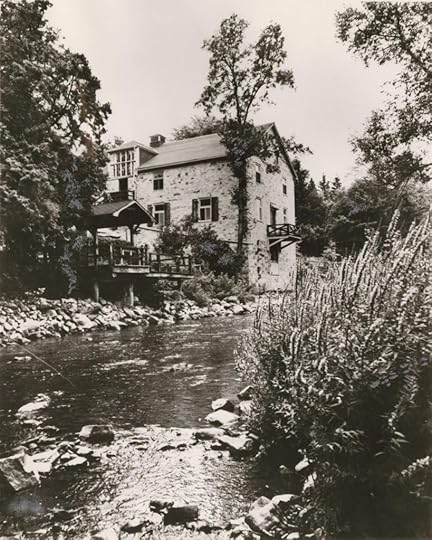
Mill of Kintail – Toronto Public Archives photo
Who is the Ghost of the Mill?
Over the course of many years of the mill’s history there have been reports of certain strange events, and to this day remain unexplained.
Some of these reports include lights flickering, footsteps, noises, and certain areas of the building are particularly active.
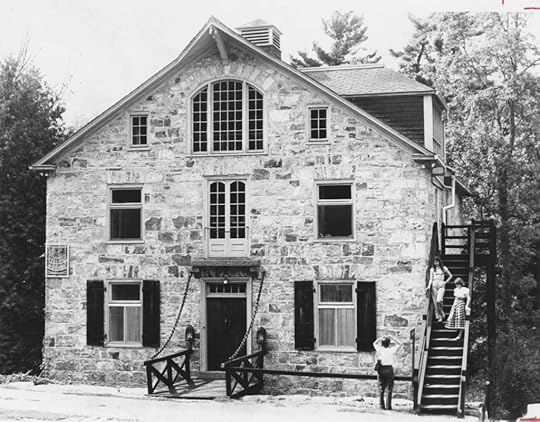
The Baird Family
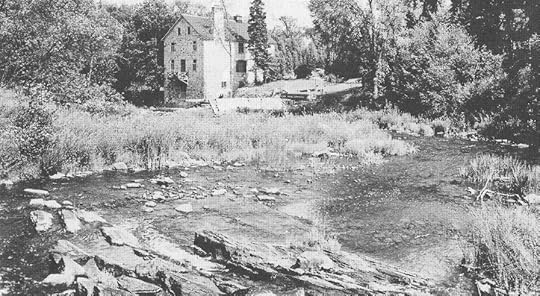
Originally known as Baird’s Mill
Mill of Kintail
Located about ten minutes from Almonte, the Mill of Kintail was built the early 1830s by Scottish immigrant, John Baird. He was a shrewd business man and through his skills and hard work, he had a gristmill, a general store and a homestead, in nearby Bennie’s Corners. He and his family lived at that location for years, but his offspring had no children of their own and when his last daughter died in 1900, the family line ended.
The Baird family had already lost ownership of the mill because of a legal dispute with his neighbours in the 1860s, and the building was abandoned. The property was no longer maintained, and not long after that, Baird passed away.
Tait McKenzie
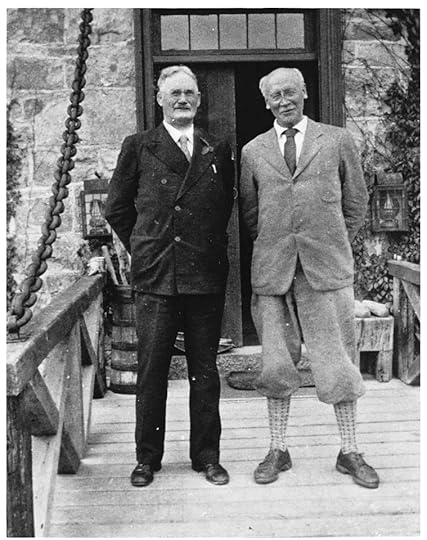
Basketball Inventor James Naismith (left) and Robert Tate McKenzie at the Mill
photo: Mississippi Valley Conservation Authority
Robert ‘Tait’ McKenzie was a well-known doctor, Almonte native, and also known for his artistic talents as a sculptor. In 1930, he returned to Almonte, his hometown, for a local celebration. During his visit he was approached by members of the community and asked whether he would be interested in purchasing the old mill as a summer home. The locals knew that the site was his old stomping ground where he played with his childhood friend, James Naismith, inventor of basketball.
After some thoughtful consideration, he realized that the property was the perfect spot for both his art studio and a retirement home for he and his wife, Ethel. Although he and Ethel purchased the property and used it mostly as a summer home, McKenzie died suddenly in 1938, and Ethel sold the property in 1952 to Major James Leyes.
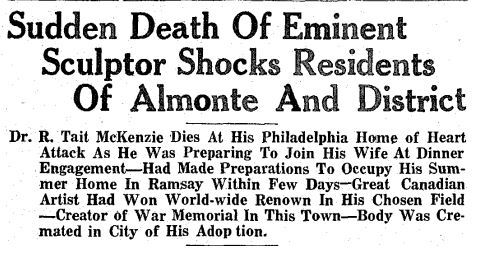
May 5, 1938, p. 1., “Almonte Gazette”
Ethel McKenzie
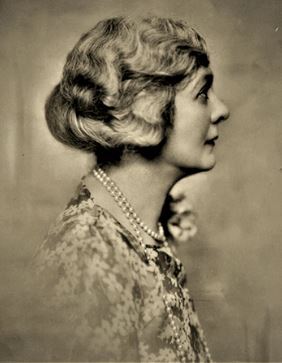
Ethel McKenzie
In 1952, Ethel McKenzie passed away, and was buried beside her husband, Tait, in St. Peter’s Churchyard.
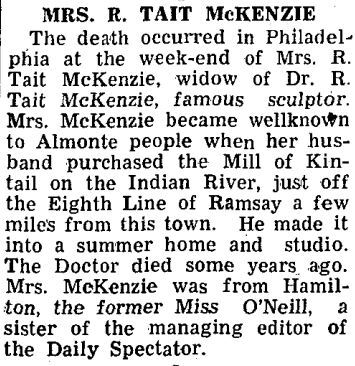
November 11, 1952, p. 1, “Almonte Gazette”
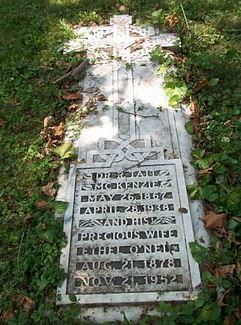
St. Peter’s Churchyard, Philadelphia, Pennsylvania
Museum Built
The Leyes family decided to establish a museum on the site, which became the R.Tait McKenzie Memorial Museum. Many distinguished guests visited the site over the years, and were always impressed by the history of the place, as well as the beautiful landscape surrounding the property.
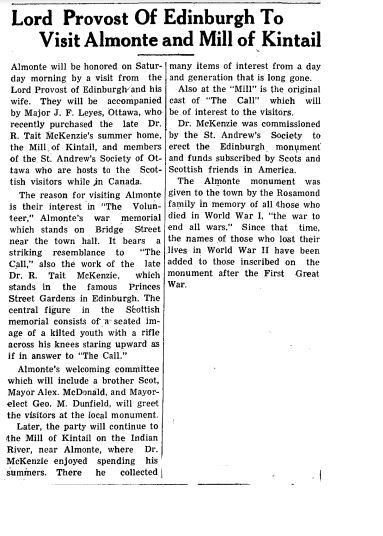
December 11, 1952, p. 1, “Almonte Gazette”
Whose spirit is haunting the Mill of Kintail?
Ethel’s Room
Over the years paranormal researchers have identified one of the ‘hot-spots’ in the mill located in what’s known as ‘Ethel’s Room’, named for Tait McKenzie’s wife. The room contains some artifacts that were owned by Ethel during her years at the mill. It’s been reported that the piano stool is often pulled out when the Curator arrives in the morning. Others have noted that the computer shuts off by itself and suddenly comes back to life on its own. In a live-feed video that was set up in the room overnight, the light came on in the middle of the night, then turned off again, although the building was locked and no one was there.
On many occasions staff and visitors to the Mill have experienced doors opening, closing, and locking by themselves, furniture moving in the night, unexplained noises in the floorboards and stairs, knocking, chilly drafts, and motion sensors being triggered when the building was closed.
On Dec. 4, 2019, Elliot Luijkenaar, and Eric Oickle, from ‘Phantoms of Yore’, an Ottawa-based paranormal group, spent from 7 p.m. until 2 a.m. conducting an investigation into the presence of spirits at the Mill of Kintail.
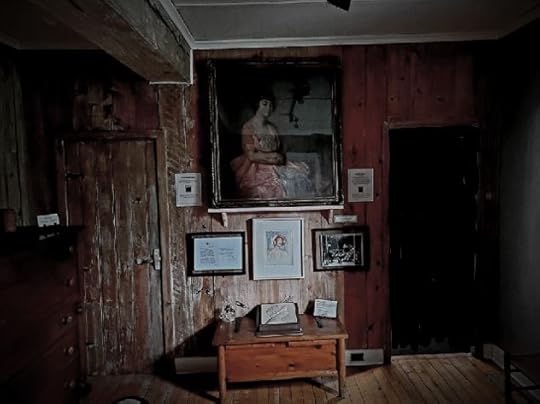
Ethel McKenzie’s room, at the Mill of Kintail
The paranormal investigators set up an electromagnetic field (EMF) meter, an REM Pod, a thermal imager, an electronic voice phenomena recorder, a video camera with the capabilities of infrared and night vision, and a spirit box.
The team later reported that some of their equipment had in fact been activated, and they believed that the energies came from more than one person. They also heard someone say the name, “Nick”, and heard footsteps at the same time. There was a sudden temperature change in the studio and it turned very cold. At that time their EMF meter was quite active, particularly when it was positioned near the staircase.
The team was so convinced of their findings, that they offered the public an opportunity to take part in one of their evening sessions at the mill. Participants attending the paranormal workshop would be shown how to use the tools of the trade; join in discussions, and enjoy a historical presentation.
As far as the staff of the mill, it’s been reported that they are content to spend their time with a visit from an occasional spirit, and claim they are friendly, though noisy at times.
Preserved for
the Future
In the 1970s the deed to the mill was transferred to the Mississippi Valley Conservation Authority and they have maintained the mill and surrounding property beautifully ever since.
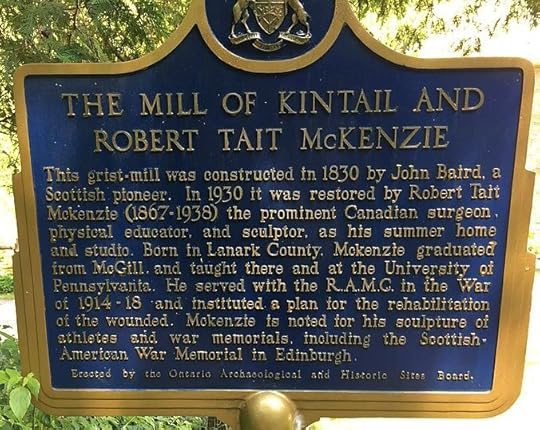
Whether or not you believe in the possibility of ghosts at the Mill, it is a lovely spot to spend the day, taking in the museum’s rich history, as well as the beauty that surrounds the property. The Mill of Kintail is surely one of Lanark County’s gems, and well worth a visit, to do some exploring, and maybe make some new memories, spending time in this historic and beautiful site.
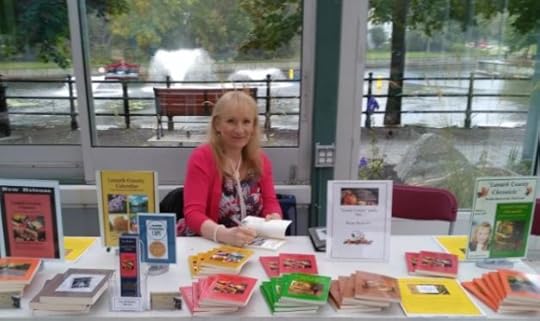
Arlene Stafford-Wilson
Arlene Stafford-Wilson
Honorary Life Member of the Lanark County Genealogical Society
Member of the Association of Professional Genealogists
Author of 11 books, “Lanark County Kitchen”, “Lanark County Christmas”, “Lanark County Comfort”, “Lanark County Collection”, “Lanark County Calling”, “Lanark County Classics”, “Lanark County Connections”, “Lanark County Calendar”, “Lanark County Chronicle”, “Lanark County Kid”, and “Recipes & Recollections”
October 7, 2023
Thanksgiving at the Stafford House
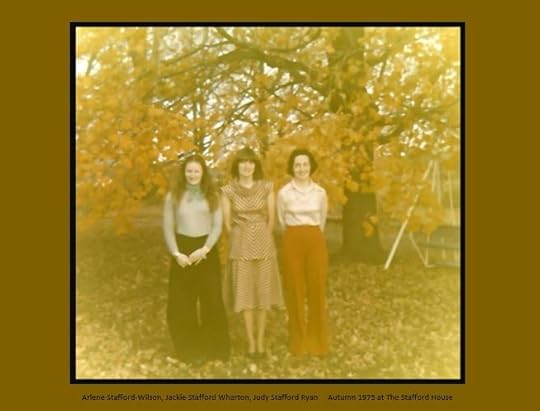
Thanksgiving
at the Stafford House
Everyone came home…..if they could. By the mid-1970s Tim and Roger were both in the O.P.P., which meant they weren’t always able to be there for family holidays. Judy and Jackie were busy with their careers, and I was at the Perth High School, trying to figure out what I’d do when the time came for me to try my luck in the world.
The setting was postcard-perfect. A big red brick farmhouse, with enormous maple trees displaying their kaleidoscope of fall colours. At the back of the house a dozen McIntosh apple trees stood, branches hanging low, loaded with ripe red fruit. By October it was warm in the daytime, and cool enough at night for local farmers to fire up their wood stoves. The rich scent of wood smoke drifted across the fields and was the perfect fall incense.
As we gathered together, the old house was filled once again with our pockets of conversation in the kitchen and living room. Dad and the boys were always talking about cars, and Mother discussed her menu with us, assigning our jobs – “fill up the pickle dish”, “pour the tomato juice into the small glasses”, “fold the napkins….diagonally across”.
In the evening after the meal there were games – sometimes cards, or maybe Monopoly. There were jokes and laughter, and unguarded conversations sprinkled with the news of the day, and our hopes for the future.
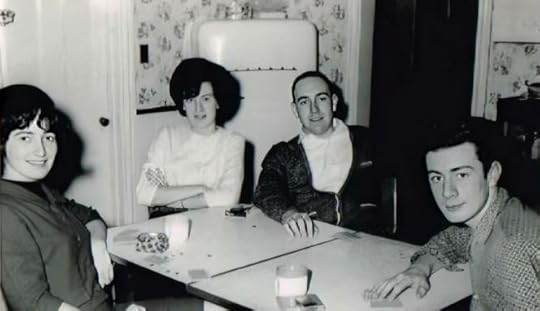
left to right – Judy Stafford, Jackie Stafford, Tim Stafford, & Roger Stafford (the kitchen at Stafford House)
Mother’s homemade stuffing was a holiday favourite. (recipe below) This old family recipe was her mother’s. Granny Rutherford’s father owned a butcher shop – the Canterbury Meat Company, in Huddersfield, England, and savory ground sausage meat was the key ingredient to their traditional stuffing, along with dried bread crumbs and seasonings.
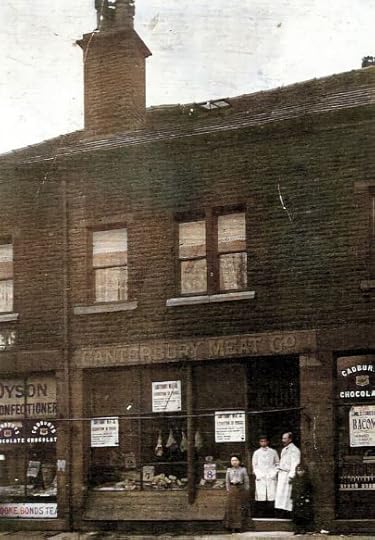
Canterbury Meat Company, 15 Market Street, Huddersfield, England, 1906

Traditional Sausage Dressing
There were lots of Thanksgiving favourites – the homemade pumpkin pie baked in Mother’s light, flaky pastry, the farm-fresh buttery mashed potatoes drizzled with velvety seasoned gravy, smooth buttered turnip, and light homemade rolls, fresh from the oven.

There would be many decades of Thanksgivings at the Stafford House on the 3rd Line of Bathurst. The setting was always the same – the sturdy welcoming red brick house, a spectacular backdrop of maple leaves in orange, red and yellow, as far as the eye could see. The sounds were always the same – the pots and pans clanging and clattering in the kitchen, Dad’s soft melodic voice sharing a joke or story with the boys, and the girls talking about the latest fashions, or a dreamy new movie star. The unforgettable scents of autumn were the same outside – the dried leaves on the ground, and the sweet McIntosh apples hanging low on the trees behind the house. Inside the scent of turkey filled the air for hours, along with the aroma of the sausage meat, and the homemade rolls baking in the oven.
Those special Thanksgivings still live in our hearts and in our minds – the times when we were all together, back in the old house, enjoying a special meal made with love for all to share, the warm smiles and the laughter, walking through the yard, under the colourful sprawling maples. We were home again.
….

Stafford House
Granny Rutherford’s
Sausage Dressing:
1 lb of sausage meat
2 eggs
1 cup hot milk
7 cups bread crumbs
1 c chopped celery
2 Tbsp chopped onions
1 Tsp salt
4 Tbsp parsley
1/2 tsp of poultry seasoning
Method: Fry meat until brown, drain off fat, add the eggs, hot milk, and the rest of the ingredients
Mother stuffed the turkey cavity, and any extra stuffing was wrapped in aluminum foil and baked in the oven.
Enjoy!

Granny Rutherford’s sausage dressing recipe from: “Recipes & Recollections: Treats and Tales from Our Mother’s Kitchen” ISBN 978-0-9877026-09, page 49.
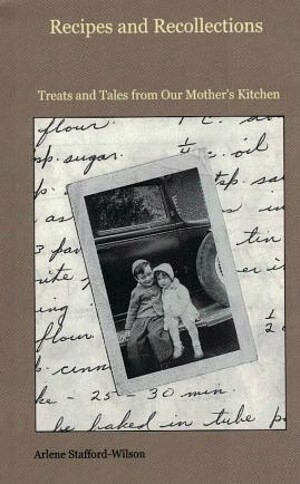
(kids featured on the cover of the book: Tim Stafford and Judy Stafford, photo taken in 1947)

Arlene Stafford-Wilson
Honorary Life Member, Lanark County Genealogical Society
Member, Association of Professional Genealogists
Author of 11 books: “Lanark County Kitchen”, “Lanark County Christmas”, “Lanark County Comfort”, “Lanark County Collection”, “Lanark County Calling”, “Lanark County Classics”, “Lanark County Connections”, “Lanark County Calendar”, “Lanark County Chronicle”, “Lanark County Kid”, & “Recipes & Recollections”
October 6, 2023
Perth Museum’s Ghosts
Perth, Ontario, is home to a number of beautiful old limestone buildings, dating back over 200 years. It’s not surprising that during this long history there have been many reports from residents, visitors, and employees of paranormal activity in the museum. Some claimed they heard unusual sounds, saw unexplained shadows, strange voices, thumping noises, or felt sudden chills or gusts of air at this old Perth landmark.
Have you experienced paranormal activity?1. Disappearance and re-emergence of objects in the house
2. Finding unidentified objects in the house
3. Appearance of unexplained marks around the house, e.g. scratches on the walls, visible streaks or scuffs on cupboards or walls
4. Hearing sounds of doors closing or opening, banging, laughter, walking, speaking, etc. in the absence of any source
5. Sudden changes in temperature
6. Lights or electronic equipment going on or off repeatedly, or not working, without any reason
7. Mobile phones not working
8. Cats or dogs whining or barking unnecessarily
9. Feeling a presence in the house
10. Feeling of being watched
A chill that travels down your spine, the unexplained feeling of dread, or a sudden drop in temperature, are physical signs that many have experienced in a haunted locale. How do places become this way? Why do spirits linger in certain buildings, or even in certain rooms?

Some say that the history of a building is almost always a primary factor. When a building is very old, and has a long history of human habitation, it’s far more likely that someone over the years has experienced strong negative feelings in that space.
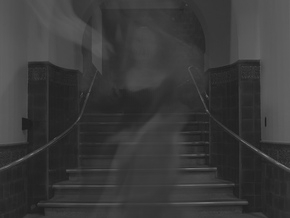
Many of the stately old buildings in Perth date back into the early 1800s. Some of these historic buildings have changed hands many times over the years, like the Perth Museum. It was first built as a home for a distinguished citizen, Senator Roderick Matheson.
Roderick Matheson’s home was one of the largest and finest in Perth. Being a Senator, he often held lavish parties in the beautiful gardens to the side and rear of his opulent home.
The magnificent garden was lush and green, with apple and plum trees, gooseberries and currants, peonies, bachelor buttons, and row upon row of breathtaking, richly-scented rose-bushes.
The garden made an impressive backdrop, where he entertained the area politicians, the wealthy, and prominent business owners of that era.
His seven daughters – Mary, Rose, Flora, Isabella, Joan, Anna, and Eliza – each one strikingly beautiful in her own way, busied themselves in the garden at the Senator’s parties, greeting guests, and offering them personal tours of the impressive grounds.
Some locals say that the daughters were so attached to these gardens, and this impressive limestone home, that their spirits lingered, long after they departed this earth, and the girls may still be seen at dusk, tending the roses, strolling in the moonlight…..

Some may not realize that the Matheson family occupied the impressive stone manor as their family home for almost a century.
Birkacre Tea RoomWhen the last family member, Eliza Matheson died in the house in 1929, the building was sold, and became the elegant Birkacre Tea Room from 1930-38, operated by William and Jessie Kinloch. Soups, sandwiches and afternoon tea were their specialties, served in the beautiful garden, during the fine- weather months.


From 1938-46 the building was called The Vanity Fair, a posh restaurant owned by Clifford and Alice Carr.
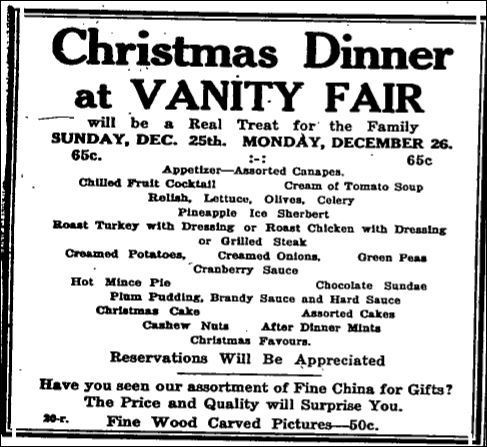
It was said that during the late 1930s and early 1940s members of the spirit world became particularly active in both the main building, as well as the gardens, as the owners played hosts to several prominent clairvoyants, at the Vanity Fair. Psychic Medium Madame Cornel was a regular guest during 1938. Madame Cornel was said to be a gifted medium, and people from the area flocked to the Vanity Fair to hear her psychic predictions.
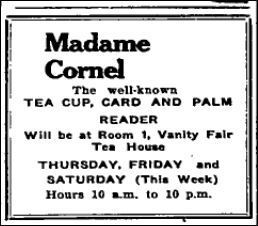

In 1939, the Vanity Fair played host to another well-known Clairvoyant from Ireland – Madame Kildare. It has been said that when Diana Kildare sat at the table and laid out her 40-year old tarot cards that you could hear a pin drop in the room.
“Unexplained Noises and Lights Along Gore Street!”There were many mysterious noises and lights seen both in the home, and in the garden, thought to be spirits brought back by the visiting psychics and mediums.
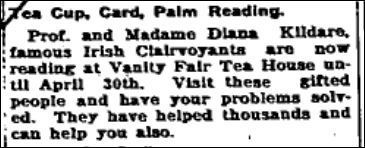
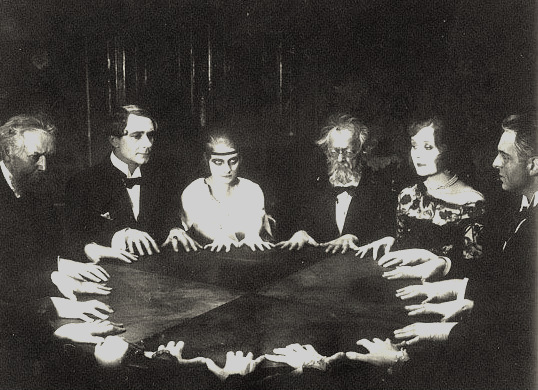
The Matheson family, particularly the beautiful daughters, didn’t seem to want to leave their home…..
Of the seven daughters in the family, only one married; and the other six girls remained at home, lavishing much time and energy tending the lush garden at the back of the property.
“I’ll Never Leave!”Although some paranormal researchers say that violence or sorrow may cause a spirit to feel bound to the world until justice is rendered, this is not always the case.
Some say it can be the strong attachment to a particular location, and that spirits may return to a place where they spent their happiest times. It’s been said that these feelings of contentment, of the person never wanting to leave, can seep into a place, either in the walls of a building, or the soil of the ground itself, and leave a certain ghostly energy or impression.
Researchers claim that ghosts tend to stay in places that they considered to be their own during their former lives, and areas that were once very closely linked to themselves as a living human being.
photo: Matheson House and rear garden (now the Perth Museum)The Matheson House family garden– For many decades, many have reported seeing shadowy figures at dusk, tending the plants and flowers.
Former employees have shared their eerie experiences over the years.
………………..
The Perth-Upon-Tay Legion bought the building in 1947, and it was their meeting place until 1967, when it became the Perth Museum.
……………….
Today, Matheson House is home to the Perth Museum, located at 11 Gore Street East in Perth.

A view of the formal Dining Room of Matheson House, restored to its former glory as a stately family home.
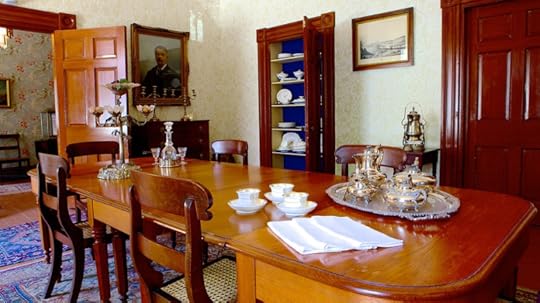
Matheson House Drawing Room – beautifully restored, one of the many grand rooms at the Perth Museum
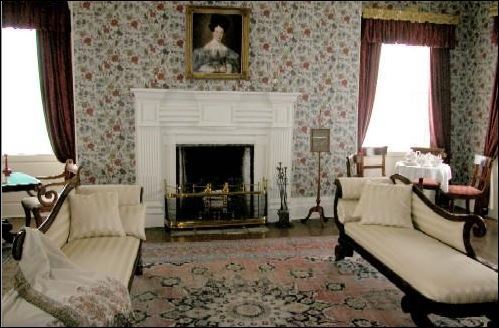
On your next visit to Perth, Ontario, step back in time at the Perth Museum, where you will see lovingly-restored rooms, decorated as they were during the years when the prominent Matheson family occupied the home.

Remember to stop by the garden, where the lovely young Matheson daughters faithfully tended their plants and flowers, and entertained prominent guests.
…………….
Don’t be surprised if you sense something unusual as you tour this old building. You may feel a draft, or see a flash of light, or movement.
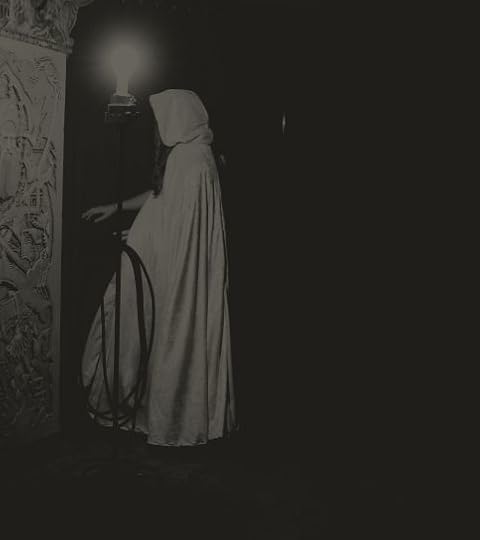
You may even feel as though someone is watching you!

…………….
…………….
For more information on the Perth Museum (former home of the Matheson Family)…………….
Tel: 613-267-194711 Gore Street East, Perth, ON, K7H 1H9……………………………………………………………………………………………………………………………………………………..

……………………………….
Read about an eerie encounter with the spirit world that took place in the 1960s. What happened on October 24th, 1967 when a young girl wandered into the garden at Matheson House? Who did she encounter? What happened next?
Discover who or what was lurking, in the haunted garden at Matheson House in:
‘Lanark County Connections – Memories Among the Maples’. ISBN 978-0-9877026-47…………………………………

Arlene Stafford-Wilson
Honorary Life Member, Lanark County Genealogical Society
Member, Association of Professional Genealogists
Author of : “Lanark County Christmas”, “Lanark County Comfort”, “Lanark County Collection”, “Lanark County Calling”, “Lanark County Classics”, “Lanark County Connections”, “Lanark County Calendar”, “Lanark County Chronicle”, “Lanark County Kid”, & “Recipes & Recollections”
October 5, 2023
Carleton Place Haunting
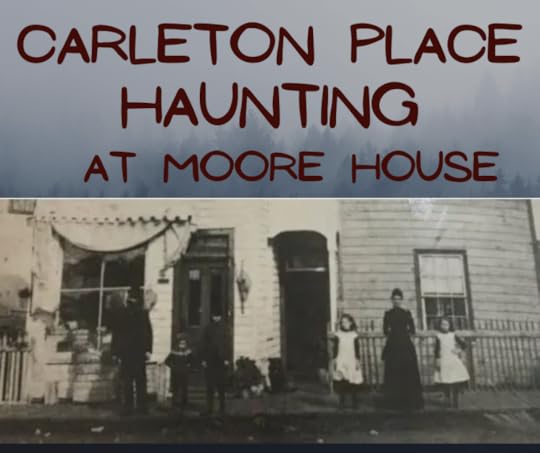
When a team of analysts from the Ottawa Paranormal Research and Investigations (OPRI), paid a visit to Carleton Place’s ‘Moore House’, in January of 2013, they had no idea what to expect.
For many years there had been rumours and gossip, stories of ghostly sounds, objects moving, sudden changes in temperature, and a long list of other sightings and events that caused the team of investigators to visit this historic place.
Moore Family
The Moore family home was built in 1850, by a settler from Ireland, Nathanial Moore, and his wife, Margaret Pearson. They had four children: William, James, Jayne Ann ‘Rossie’, and Richard.
James, the second eldest son, and his wife, Catherine Roberts, inherited the home from his parents, and in turn, raised their own children there.
James and Catherine Moore, had a family of five: Nathaniel, born in 1875, John in 1876, a daughter Ida Louise in 1879, another girl, Clara in 1882, and a son, Ernest in 1885.
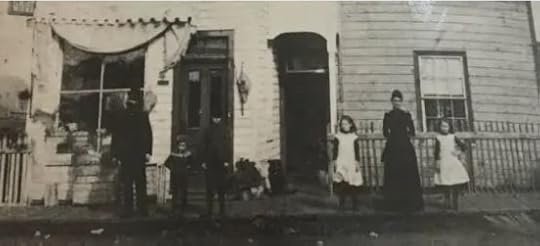
The photo above shows the section of the Moore family house which was converted to a small general store, known as, JP Moore Groceries and Confectionery. This photo is from the late 1800s.
(left to right – James Moore, his sons, Ernest, Herbert, daughter Ida, wife Catherine, and daughter, Clara)
The Moore’s third child, Ida Louise, was not only lovely, but was also a gifted musician, and became known for her technically impressive performances on the piano.
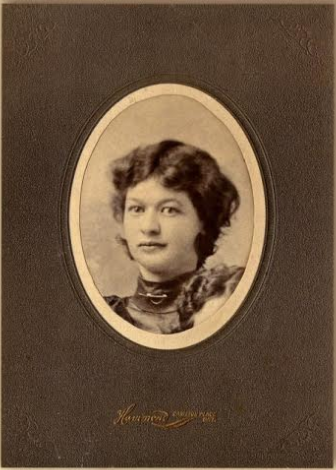
photo of Ida Louise Moore –
Carleton Place & Beckwith Heritage Museum
Local lore says that Ida’s talent was well worth pursuing in a professional capacity, and that she had planned to attend music school, and either perform professionally, or possibly teach music one day.
Ida’s Death
In a sad twist of fate, the promising young musician caught tuberculosis, and became quite ill. Eventually, in 1900, at the tender age of 20, Ida passed away. It was said that the whole town mourned at the loss of such a lovely young lady, and one with so much promise for a bright future. With heavy hearts her parents, James and Catherine found a lovely plot, under some tall shade trees, at St. James Anglican Cemetery, just north of Carleton Place.

St. James Anglican Cemetery
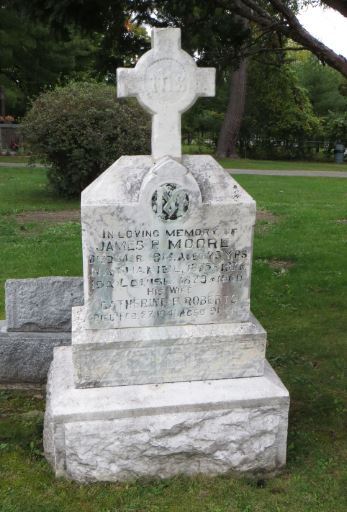
Moore family headstone, St. James Anglican Cemetery, Carleton Place
Spooky Store
Eventually, the Moore family sold the home, and the new owners continued to operate the small general store. It was after the building changed hands that the strange and unexplained events began to take place.
Reports of unusual sounds and changes in temperature at the store began to make the rounds, up and down the streets of Carleton Place. There were stories of sudden drafts, and of windows opening and closing on their own, the radio also turned off and on by itself, and footsteps were heard, even when no one was in the building. Many employees refused to work alone in the building, and eventually it became difficult to find people who would agree to work there at all.
Paranormal Investigation
In 2013, when the Ottawa Paranormal Research and Investigations team members conducted their research at the Moore House, their three-hour term of analysis included numerous video and audio recordings designed to detect electronic voice phenomenon (EVP) and other indications of paranormal activity. Their equipment included: electromagnetic field (EMF) meters, thermal imagers, video cameras fitted with infrared and night vision, spirit boxes, computers, and smartphones.
What Did They Find?
The team returned to the Moore house in July of 2013, to discuss their findings. Present at the meeting were Chamber staff, members of the media, a Moore family descendant, Frances Moore, and her partner Jim Smithson.
The first piece of evidence shown to the group was a video clip, taken in the loft at the beginning of the investigation on Jan. 13. Analysts John Moore (no relation), and OPRI Psychic, Craig Leafloor, were conducting the initial walk-through.
Thermal Image
One of the research team revealed a thermal image captured by using the thermal imaging camera.

“That chair should not be white,” he explained. “That is heat.” “No one had sat in that chair, but you can clearly see the legs and torso.”
It was a bit of a surprise, and quite strange to have a heat signature showing up in a chair that no one is sitting in; especially white hot like that.
Electrical Interference
At one point during the evening, their recording picked up what sounded like electrical interference.
“Usually, if we get electrical interference, we get it multiple times, it comes in intervals,” he said. “You do not hear it once in a three-hour recording.” The noise can be heard beneath the voice of an investigator.

The Sound
of Music
Knowing that Ida was an accomplished pianist, the team attempted to make contact with her using an electric keyboard , as a trigger object.
Using a spirit box, one of the researchers asked, “Ida, what instrument do you like to play?”

Spirit Box
After a brief pause, a noise came from the keyboard.
According to the researchers everyone heard the noise, and the keyboard was not plugged in at the time.

A Gentleman?
The research team also revealed that just before everyone heard the keyboard, two voices were also heard in the room – a male and a female.
Two separate pieces of equipment recorded the voices, and the word, “No” is said by the male voice, followed by a “Yes”, from the female voice.
In an interview with the “Canadian Gazette”, the research team concluded that the spirit of Ida was still in the Moore house, along with a gentleman’s presence.
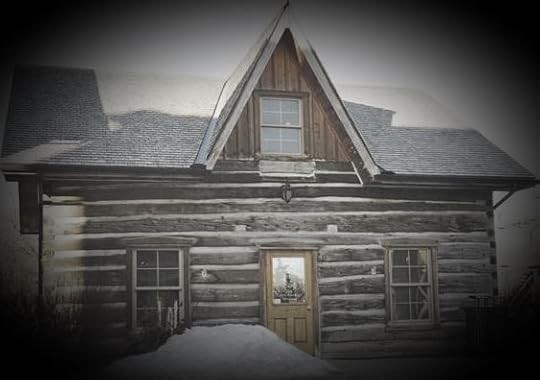
Moore house in more modern times, 170 Bridge Street, Carleton Place
House was Moved
The Moore house was originally built at the north end of Moore Street, opposite Lansdowne Avenue. The building was donated to the town, and in 2007, the structure was raised from its foundation and moved to 170 Bridge St. The building is currently the site of the Carleton Place & District Chamber Of Commerce and Visitor Centre.
According to some family members, the Moore family were “known to have the sixth sense, an ability to perceive the unseen world of angels, ghosts, heaven, auras, etc.”
Local residents say that a realtor, Walter Renwick, owned the property for many years, and that members of his family reported unusual things upstairs where their bedrooms were located. They reported objects moving, breezes flowing through rooms when the windows were closed, and a strong scent of lavender from time to time. It’s also been said that the day Renwick sold the home, a framed photo he had of the house fell to the floor and shattered into pieces.
Lavender
Some paranormal researchers claim that the scent of lavender is one of the signs of a friendly spirit. Down through the ages we’ve come to know that lavender symbolizes purity, faith, and love; and for a certain young lady living in Carleton Place so many years ago, it may very well have been a favourite.

Today, Moore House is the bright, welcoming Carleton Place Visitor Centre and the Carleton Place & District Chamber of Commerce.
Are there still spirits at Moore House? Why not go and see for yourself!
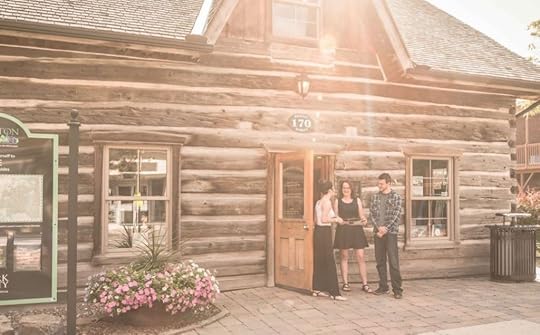
photo: Carleton Place Chamber of Commerce
.

Arlene Stafford-Wilson
Honorary Life Member, Lanark County Genealogical Society,
Member, Association of Professional Genealogists, APG
Author of:, “Lanark County Christmas”, “Lanark County Comfort”, “Lanark County Collection”, “Lanark County Calling”, “Lanark County Classics”, “Lanark County Connections”, “Lanark County Calendar”, “Lanark County Chronicle”, “Lanark County Kid”, and “Recipes & Recollections”
October 4, 2023
Ottawa Valley Poltergeist

This eerie tale began in the autumn of 1889, on a farm, owned by George Dagg, and his wife, Susan, located in Clarendon, 10 kilometers from Shawville, Quebec.
George and Susan had three children at that time, Eliza, age 4, Mary, age 3, and baby John. The Dagg family had also taken in a young girl, 11-year old Dinah. Like many orphans from the U.K. at that time, she was brought to Canada, and these children were often placed in farm homes, where they could help out.
When Dinah was present, there were often unexplained, spontaneous fires — eight occurring in a single day. Objects – a water jug, butter tub and wash basin ‘flew’ around the property controlled by an “invisible agency.” Stones were thrown through windows, a harmonica played on its own, and an empty rocking chair, rocked back and forth.
Family members and neighbours heard a deep gruff voice, sounding like an old man, in the house and outdoors, and the voice answered questions, and was heard by all.
It all began on September 15, 1889…..
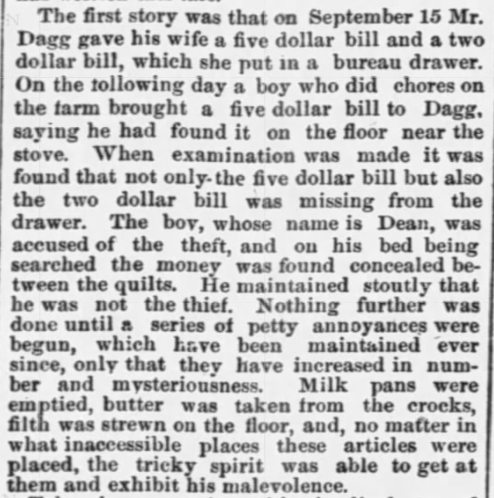
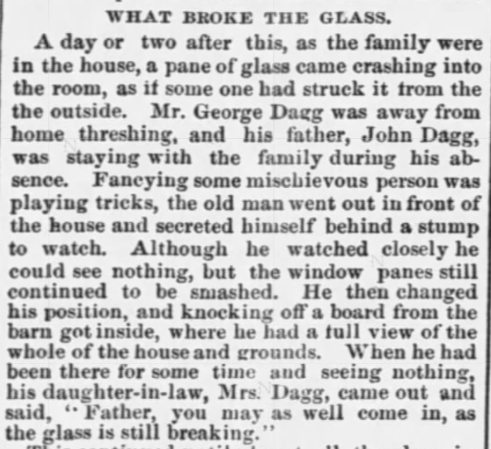
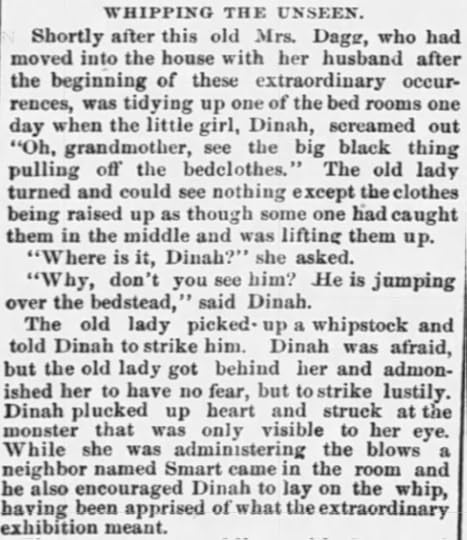
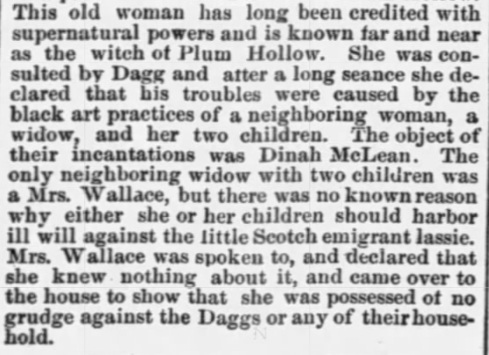

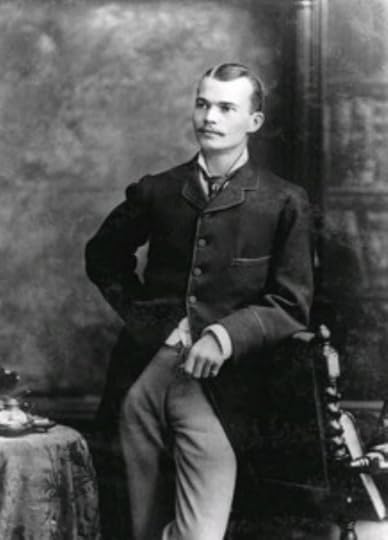 Percy Woodcock, 1879Was it the farm-hand, Dean?
Percy Woodcock, 1879Was it the farm-hand, Dean?
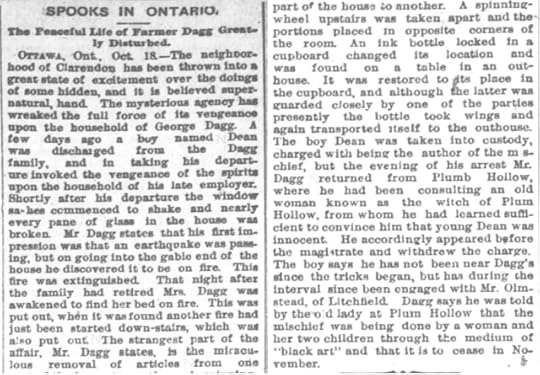
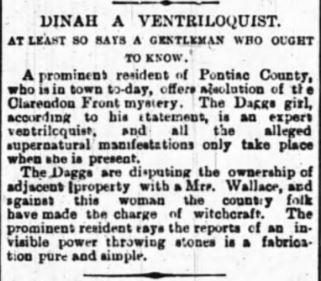
Dinah Burden McLean, the adopted orphan from Scotland, taken in by the kindly Dagg family, was blamed for the disturbances, and eventually was sent away to Fairknowe Home, in Brockville. Fairknowe Home was an orphanage, and at the time Dinah was sent there, it was called The National Orphan Homes of Scotland, and later the building housed a division of the Brockville Children’s Aid.

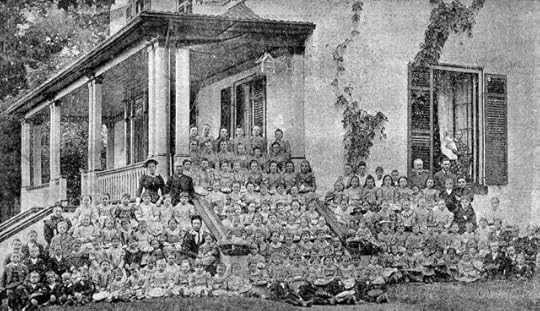

Seventeen farmers and community leaders, including local politicians and clergymen, signed witness statements to the unusual sightings, and voices heard at the Dagg farm, in the fall of 1889.
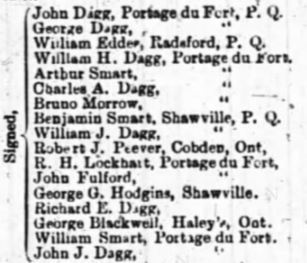
We, the undersigned, solemnly declare that the following curious proceedings, which began on the 15th day of September, 1889, and are still going on, on the 17th day of November, 1889, in the home of Mr. George Dagg, a farmer living seven miles from Shawville, Clarendon Township, Pontiac County, Province of Quebec, actually occurred as below described.
1st, That fires have broken out spontaneously through the house, as many as eight occurring on one day, six being in the house and two outside; that the window curtains were burned whilst on the windows, this happening in broad daylight whilst the family and neighbours were in the house.
2nd, That stones were thrown by invisible hands through the windows, as many as eight panes of glass being broken; that articles such as waterjug, milk pitcher, a wash basin, cream jug, butter tub and other articles were thrown about the house by the same invisible agency; a jar of water being thrown in the face of Mrs. John Dagg, also in the face of Mrs. George Dagg, whilst they were busy about their household duties, Mrs. George Dagg being alone in the house at the time it was thrown in her face; that a large shelf was heard distinctly to be played and was seen to move across the room on to the floor; immediately after, a rocking chair began rocking furiously. That a washboard was sent flying down the stairs from the garret, no one being in the garret at the time. That when the child Dinah is present, a deep gruff voice like that of an aged man has been heard at various times, both in the house and outdoors, and when asked questions answered so as to be distinctly heard, showing that he is cognizant of all that has taken place, not only in Mr. Dagg’s family but also in the families of the surrounding neighbourhood. That he claims to be a discarnated being who died twenty years ago, aged eighty years; that he gave his name to Mr. George Dagg and to Mr. Willie Dagg, forbidding them to tell it. That this intelligence is able to make himself visible to Dinah, little Mary and Johnnie, who have seen him under different forms at different times, at one time as a tall thin man with a cow’s head, horns and cloven foot, at another time as a big black dog, and finally as a man with a beautiful face and long white hair, dressed in white, wearing a crown with stars in it.
Signed,
John Dagg Portage du Fort, PQ.; George Dagg, Portage du Fort, PQ; William Eddes, Radsford, PQ; William H. Dagg Port. du Fort; Arthur Smart, Port. du Fort; Charles A. Dagg, Port. du Fort; Bruno Morrow, Port. du Fort; Benjamin Smart, Shawville, PQ.; William J. Dagg, Shawville, PQ.; Robert F. Peever, Cobden, Ont.; Robert H. Lockhart, Port. du Fort; John Fulfrid, Port. du Fort; George H. Hodgins, Shawville; Richard F. Dagg, Shawville; George Blackwell, Haley’s, Ont.; William Smart, Portage du Fort; John J. Dagg, Portage du Fort.”

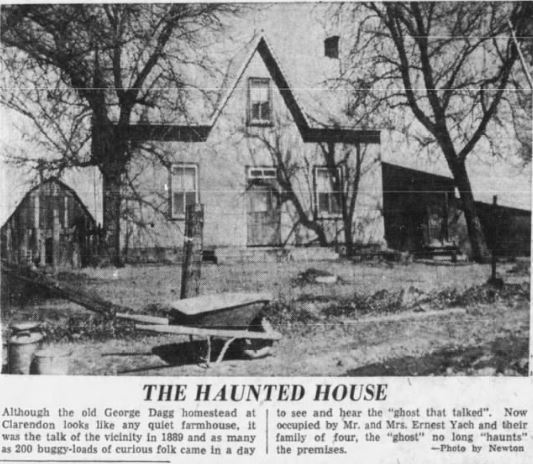
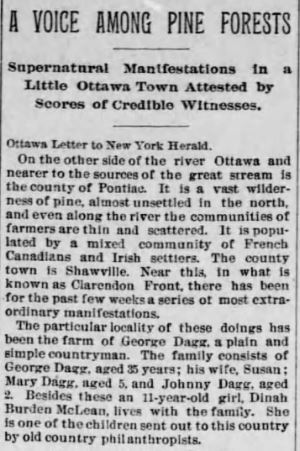
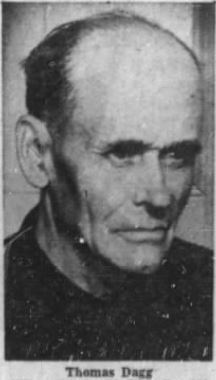
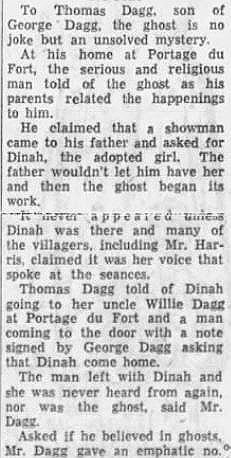
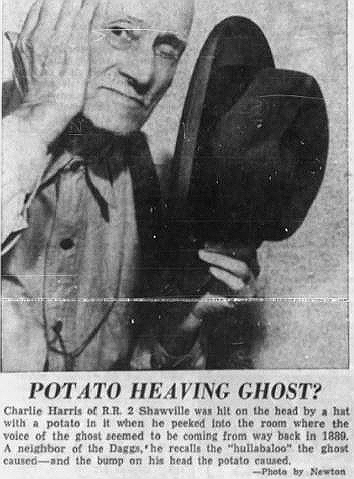


Noted by the Lombard family – a strange sound of crawling and scratching in the attic, solely focused above the original house.
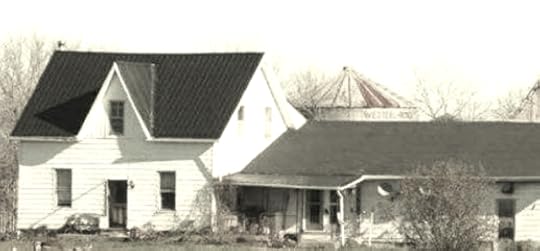
Eliza Jane, age 4, the Dagg’s daughter, died mysteriously, during the time of the poltergeist’s visit.
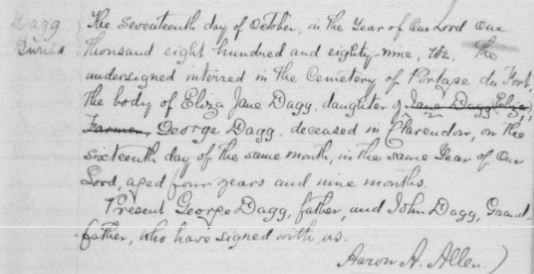
Grave of Eliza Dagg, daughter of George and Susan Dagg. She passed away in a mysterious accident, during the time of the poltergeist on the family farm. (local lore is little Eliza was playing near a cauldron of soap, her clothing caught fire, and she burned to death)
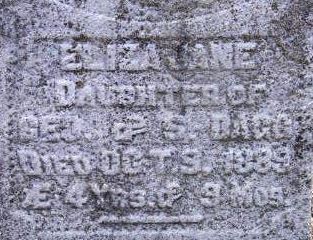
After the disturbances of 1889, the lives of George Dagg and his family returned to normal, for the most part. George became one of the most prominent farmers in the region, and served as a Councillor for Portage from 1918-1922. Popular, and well-respected, he ran for Mayor in 1922, and was elected. He served as Mayor of Portage for 16 years, right up until his death, in 1938.
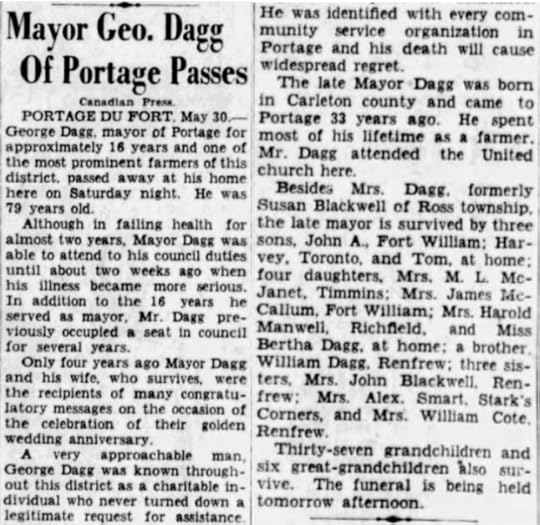
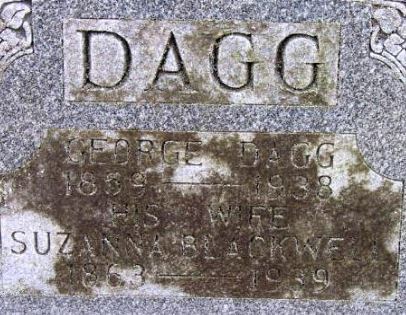
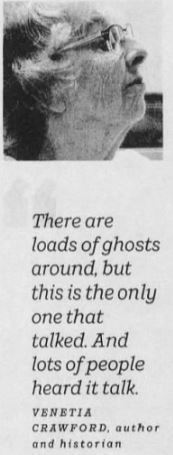
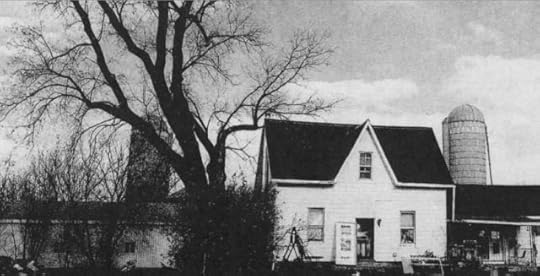
The old-timers say that the poltergeist vanished, and appeared like a streaking flame, as it finally left the Dagg farm, after three long months, of troublesome behavior.
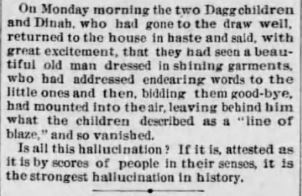
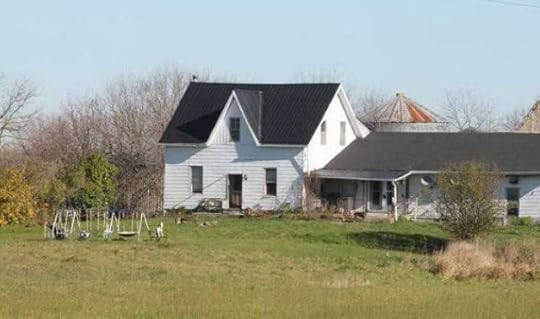
The Dagg House, as it appears today. Local people and curiosity seekers still drive by this property, and local teens have been known to walk through the yard at night, on a dare.
Would You Dare to Visit at Night?
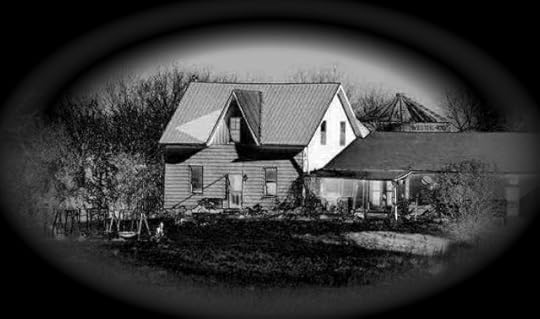
Exploring the Supernatural: The Weird in Canadian Folklore
1955. R.S Lambert’s book Exploring The Supernatural: The Weird In Canadian Folklore was published, which includes a chapter of what took place at the farm in 1889.
…..
The Ghost that Talked
The Dagg poltergeist was the subject of 1957 National Film Board movie, “The Ghost That Talked.”
“In the fall of 1889 a mysterious presence took up residence in the Dagg farmhouse in Pontiac county, Québec. This dramatization based on the first-hand report by Canadian artist Percy Woodcock shows that ghosts and poltergeists are as common in Canada as in the Old World.”
March 10th, 1957, 30 min.
…….
Fairknowe Home
For more information on Fairknowe Home, orphanage in Brockville: “The Village, A History of Quarriers” , by Anna Magnusson, 1984.
…….
Arlene Stafford-Wilson
Member, Association of Professional Genealogists
Member, Lanark County Genealogical Society
Author of 10 books: “Lanark County Christmas”, “Lanark County Comfort”, “Lanark County Collection”, “Lanark County Calling”, “Lanark County Classics”, “Lanark County Connections”, “Lanark County Calendar”, “Lanark County Chronicle”, “Lanark County Kid”, & “Recipes & Recollections”
October 3, 2023
The Witch of Plum Hollow
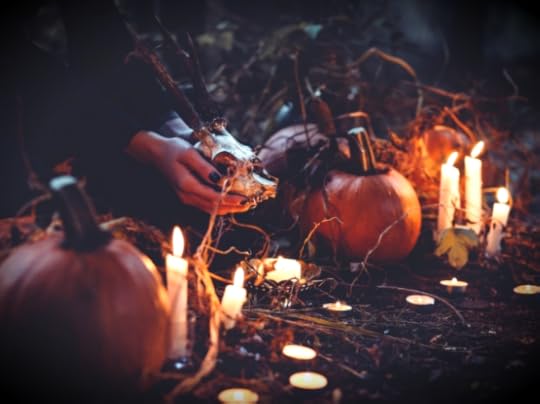
The readings always began the same way, with her visitors climbing the rickety wooden stairs to her cramped attic reading room. She motioned her guests to sit across from her, at a small pine table. A fresh pot of tea sat on the table, along with two cups. She’d pick up the pot, shake it vigorously, and pour a cup, watching as the leaves slowly sank to the bottom. Next, she swirled the tea around, poured the liquid back into the pot, then instructed her visitor to do the same.
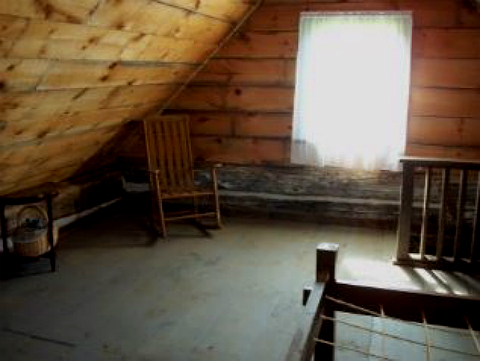
Jane Elizabeth Martin Barnes was a beautiful young woman, when she arrived in North America. She left her home in England after refusing to marry a man twice her age. Her father, a Colonel, had instructed her to wed his friend, an unattractive middle-aged soldier, and Jane would have no part of it. Instead, she fell in love with a handsome young man, Robert Harrison, and they left Britain together, married, and had a son.
Sadly, Robert died shortly after they settled in Ontario, and Jane was left alone to raise their baby.
Jane had a lovely slim frame, fair complexion, and bright eyes. It wasn’t long before she began to date again, and a young shoemaker, David Barnes, won her heart. They married, and settled near Lake Eloida, not far from Plum Hollow, about fifteen miles south of Smiths Falls, in Leeds & Grenville, Ontario. Jane and David had a large family – six sons, three daughters, and Jane took in three neighbourhood orphans after their mother passed.
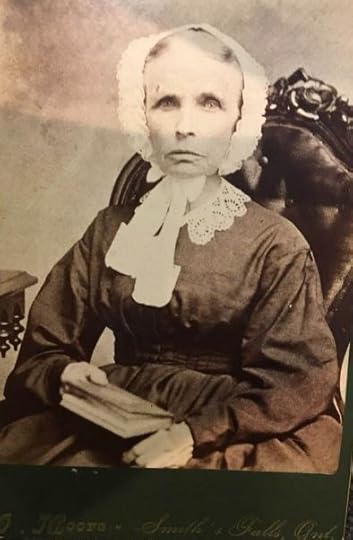
Jane’s husband David, was a bit of a wanderer, and he left her, abandoned the children, and moved to Smiths Falls. After her husband left, Jane’s son Williston ‘Ton’, and his family, moved into the little cabin with Jane, to offer her support.
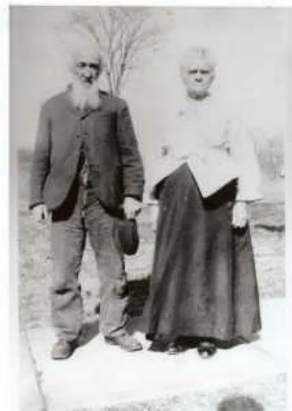

David Barnes, Jane’s estranged husband, moved in with their son Samuel Barnes, who had a home in Smiths Falls, and who later became Mayor.
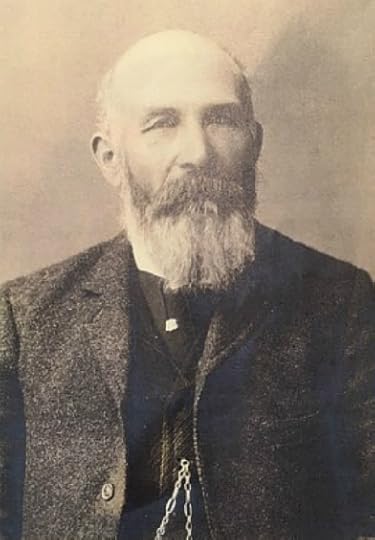
Samuel Barnes was among several other prominent business leaders who brought about the incorporation of the ‘Smiths Falls, Rideau, and Southern Railway Company‘, in January of 1898. The purpose of the incorporation was to construct and operate railways in, through and from the Town of Smiths Falls, in the County of Lanark.
The other members were James Maitland Clark, John Reeve Lavell, Alpheus Patterson, Richard Alexander Bennett, Matthew Ryan, Robert J. Brodie, Adam Foster, Robert Hawkins, George T. Martin, and Alexander Gray Farrell, all of the Town of Smiths Falls.
Samuel married Agnes Chalmers, and they had a large family of 10 children. Their youngest was Roy Barnes.
Roy Barnes in 1947, Grandson of Mother Barnes (Witch of Plum Hollow)
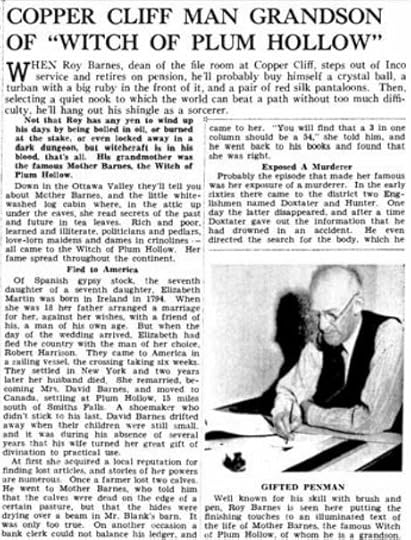

Jane, in need of an income to raise all of their children, began to read tea leaves.
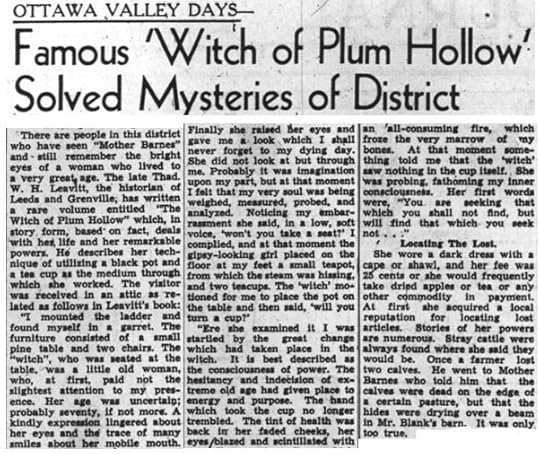

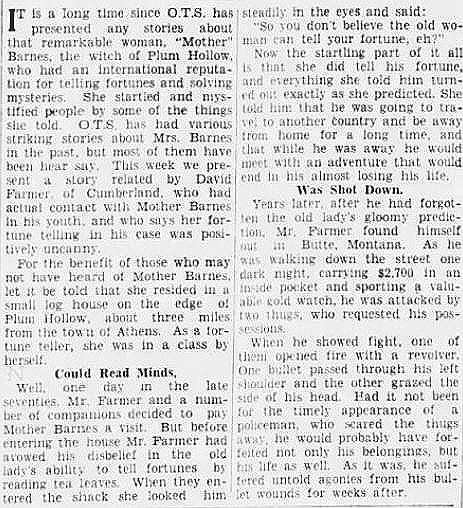

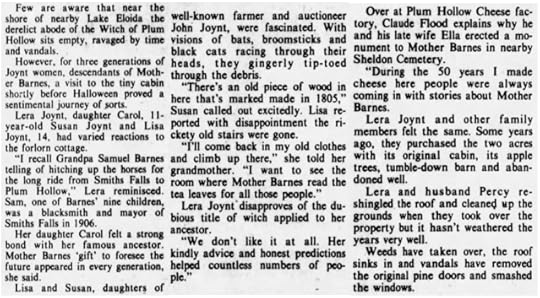
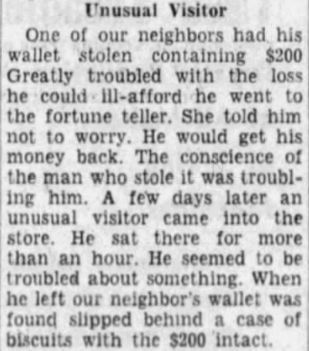
In the late 1800s, telling one’s fortune by reading tea leaves became very popular.
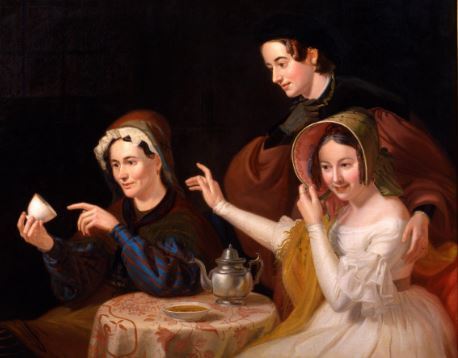
In those days, loose tea was used, and so the leaves at the bottom of the cup often formed shapes or patterns, and these were interpreted by the fortune-teller, to predict future events.

Loose tea was measured into a tea pot filled with boiling water. After the tea was consumed, the loose leaves lay at the bottom of the cup
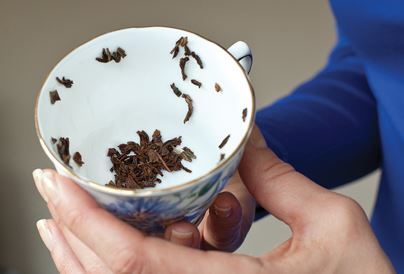
Then, the fortune-teller, or tea-leaf-reader, would interpret the meaning of the individual’s leaves.
Many believed that the position of the leaves in the cup itself, had meaning.


The images of the leaves in the cup were often matched with a series of standard symbols, used by many in the trade.

News of Jane’s accuracy in her predictions spread quickly, and she had visitors from neighbouring towns, cities, provinces, and even visitors from the northern states.
One of her most famous customers was the future Prime Minister of Canada, John A. MacDonald.
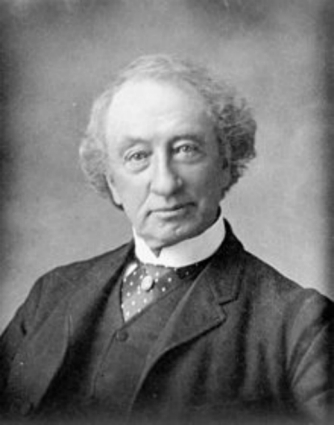
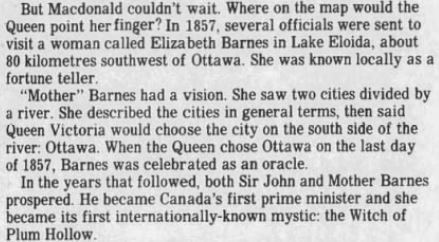
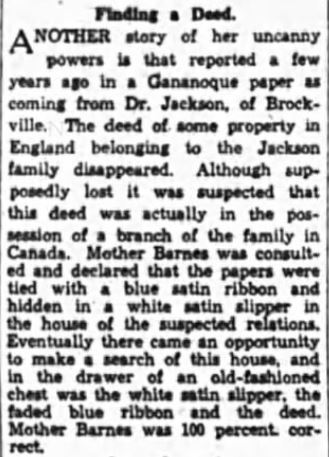
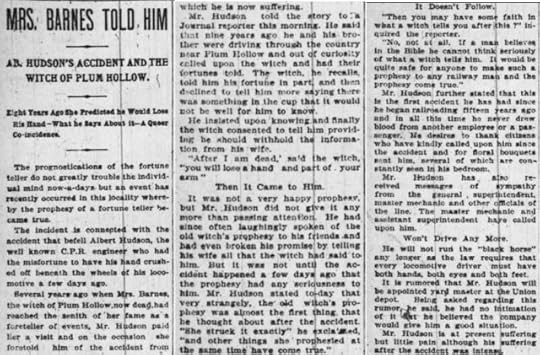
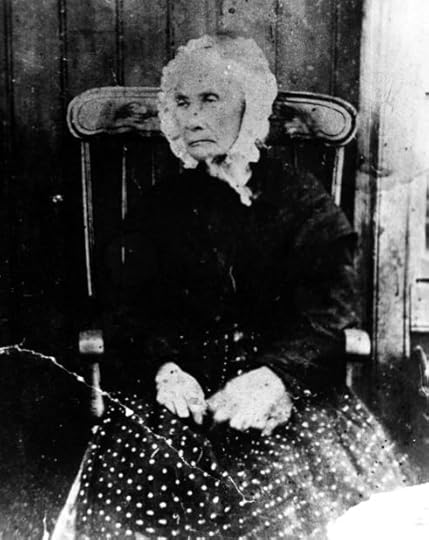
“As promised, we shall, here and now endeavor to do justice to the memory of a lady of the old school, who truly had as keen and as well trained and as thoroughly disciplined an intellect as anyone of our day and generation in our beloved native county. We refer to our long ago departed and much respected fellow citizen, who was early known as “Mother Barnes”, who as her years increased was usually designated as “Old Mother Barnes” and who was unjustly, and with crude irreverence, spoken of by those who knew her least as “The Witch of Plum Hollow.” The Old Farmersville folk never called her by such a name, nor did any of her neighbours who knew her best, for all who were intimate with her respected her and treated her with deference. It is true that she had a sharp tongue, but the only folk who ever felt its stinging lash were those from far distant parts who at times came into her presence with boisterous demeanor. She was pre-eminently fitted to handle just such a case and in a few crisp quietly spoken, even gentle words, she promptly put the culprit in his place and engendered in his heart and mind an infinitesimally small estimate of his own worth and importance in affairs terrestrial and in divine matters of the spirit world. Such a smart visitor went away dazed and with a deep realization of the fact that here in the backwoods of Canada was a personality which dominated everyone and everything in a manner far transcending that of any of the national orators, preachers, politicians, lecturers, phrenologists and other celebrities then the vogue in New York, London, Paris. This characteristic, and her native ability to see right through everyone, and even turn their minds and thoughts inside out, after a few moments’ conversation: these two God-given attributes made Mother Barnes famous and compelled the people to beat a track to her door to her little tea studio up under the eaves, for many long years.
If anyone wishes to make a shrine of the old home of Mother Barnes, which would be a fitting way to perpetuate her memory, he can easily locate the house by turning north from Main Street, Athens, at Sydney Taplin’s old corner, now owned by Mrs. Avis Daniels Harte. He should then proceed along Elgin Street, past the Area Parish Memorial Park on his right, and so along Livingstone Avenue, past the Villa to the Guide-board corner. Here, he should turn neither to the left along Wright Avenue to Plum Hollow, nor to the left along Robeson Avenue to Hard Island. He should keep straight ahead north along Eliada Parish Avenue to Mother Barnes Avenue, which is the town-line between Yonge and Kitley. There, on the southwest corner is Mother Barnes’ old home, Lot 13, Concession 11 Yonge. Mother Barnes Avenue runs from Atkins Lake, north of Rockspring, through Eloida, all the way to Soperton.
Mother Barnes was born Elizabeth Martin. She was a dearly loved daughter of Col. Martin, of the British Army, but when she came of age, she ran away with the man of her choice, Sergeant Robert Harrison, coming to America in a sailing ship which took six weeks in crossing. Thus, having disobeyed the wishes of her parents, she was a stranger to them during the rest of her pilgrimage below, true to the then prevailing mode in English families of the military, clergy, and gentry class. Elizabeth ‘Jane’ Martin, and her husband settled in Cobourg, Upper Canada, where one son, Robert Harrison Jr., was born to them, who in later life became Colonel Robert Harrison, commanding officer of a regiment from Kansas in the American Civil War. Col. Robert Harrison died in Kansas, and his mother in her home, at the corner of Mother Barnes and Eliada Parish Avenues, had his pictures in full regimentals. After the death of her husband, Robert Harrison, the elder, Mother Barnes, then known as Mrs. Elizabeth Martin Harrison, married David Barnes, an American, by whom she had nine children. John and Thomas died in youth. Next came Lucy, born in 1837, who married Joseph Haskin, of Plum Hollow. They moved to Modale, Iowa, travelling in a covered wagon. After the death of her husband, Lucy married a cousin of our dear old neighbour, Horace Brown, of Farmersville. She last visited her Athens cousins in 1906 but died some years ago. Next, came Samuel Barnes, a blacksmith, who married Agnes Chalmers of Montague, near Smiths Falls, a cousin of our old chum, Will Chalmers. Their daughter, Mrs. Lily Barnes, still resided in Smiths Falls when the record was made a few years ago. It was in the home of Mrs. And Mrs. Samuel Barnes, Smiths Falls, that David Barnes, husband of Mother Barnes, died. The next child was David Barnes, also a blacksmith. He went to Iowa in early life and died there. Next came Margaret, who married Arthur Robeson, of Sharbot Lake, where she died. Next came George of Athens, who married Clare Kyo, of Watertown, N.Y., and died young. Next, came Williston Barnes, of Eloida, who married Lydia Compo. Last came Jane Elizabeth Barnes, (Janie) born March 1st, 1847, who was the wife of our very popular old neighbour, Charlie Wing, of Farmersville. Mrs. Wing died Nov. 10, 1910. In one of our stories we described the home of Mr. and Mrs. Wing, on Elgin Street, which was one of the neatest, best kept and most attractive in the village. An adopted daughter of Mother Barnes and her husband David was Bella Sheldon, who was the wife of our cheerful old neighbour, Erastus Livingston.
And now we feel better, for we have completed a pleasant task, which has confronted me for a long time. We wanted to do justice to Mother Barnes, but it is not until now that we have been able to get around to it. We think that our good friend, Prof. Fred Lawdon, of the Historic Sites and Monuments Board, should see to it that the site of the old home of Mother Barnes is suitably marked for the enlightenment of posterity. Canada has never had as one of its citizens a lady of stronger character or keener intellect than Mother Barnes and this brief story of her life, which will be permanently preserved in the Canadian Archives, should be called to the attention of posterity by a suitable marking of the place of her residence and the centre of her activity, her old home near Lake Loyada (Eloida). Thus, Elizabeth Martin, a daughter of the gentry of England, lived among us for three-quarters of a century. What did she think of us? If she had put her impressions in the form of a book, it would now have an enormous sale.”
She predicted the location of money stolen from a resident of South March
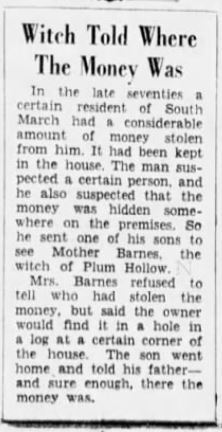
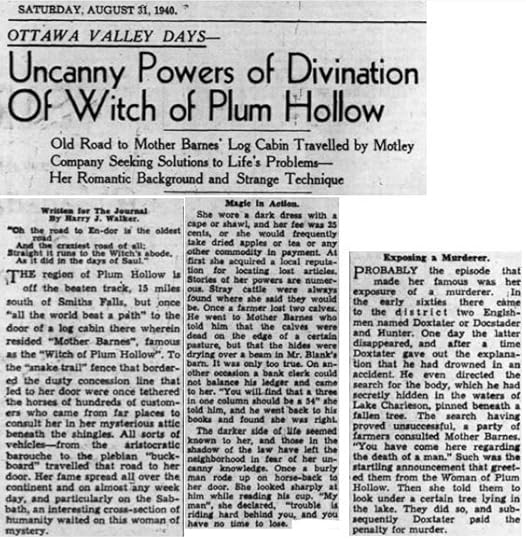
During Jane’s time telling fortunes she was able to find missing objects, missing farm animals, and even missing people. Jane’s predictions were so accurate that even the police called on her to assist them from time to time. She even had a few very famous customers, in the many decades of her practice, in that little cabin in the country.
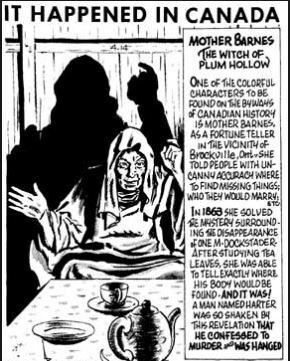
As the decades passed, news about Jane’s gift for predicting continued to spread far and wide, and there were often carriages lined up down the road near her little cabin.
“It was alleged by many, that Mrs. Barnes could tell all about a person, a hair from whose head was presented to her.”
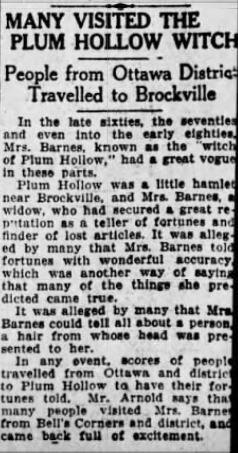
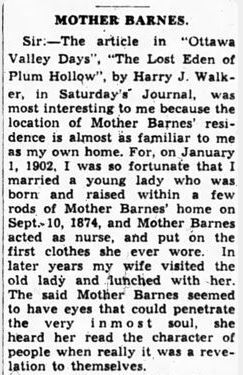
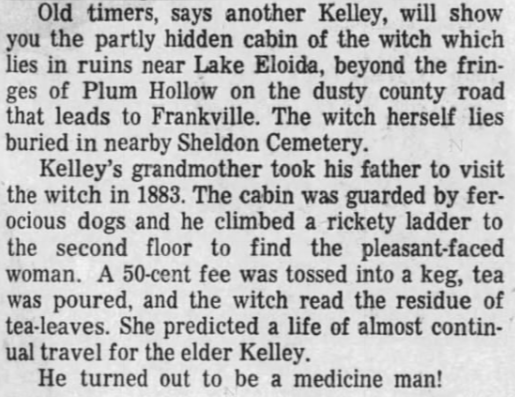
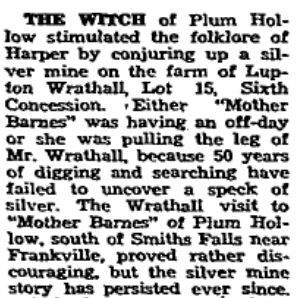
Young people went to Jane, to ask advice on their love lives, and she was able to predict who they would marry. If any of the neighbours misplaced anything, they walked to Jane’s little cabin and she would tell them exactly where to look. Farmers went to Jane when their cattle or horses wandered off, and she always directed them to precisely the right spot. Business people consulted Jane for advice on their professions, and politicians sought her advice on elections and policies.
“The walls in the little room downstairs, were closely covered with the names of people from Canada and the United States, who had come to have their fortunes told.”
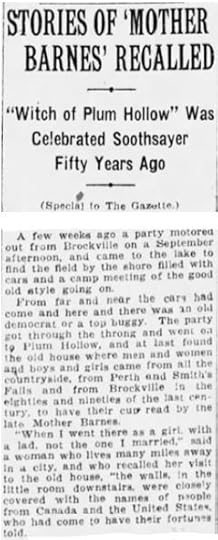
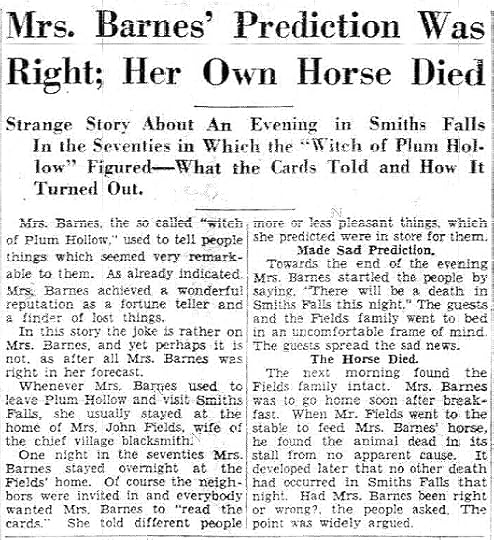
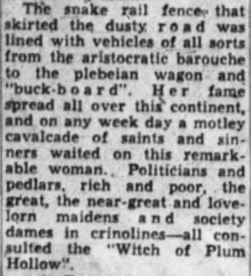
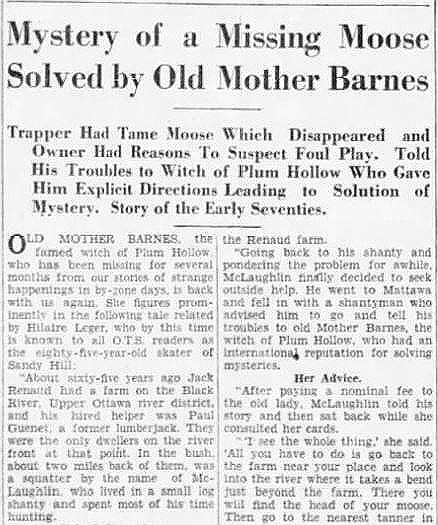
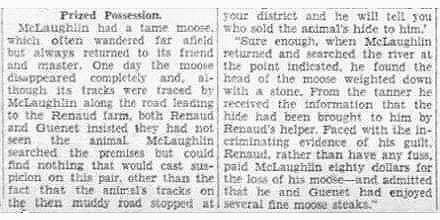
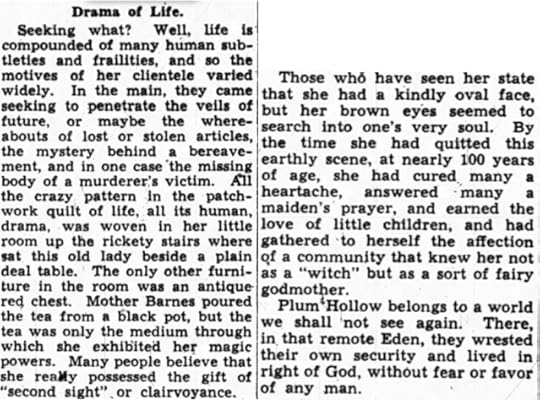
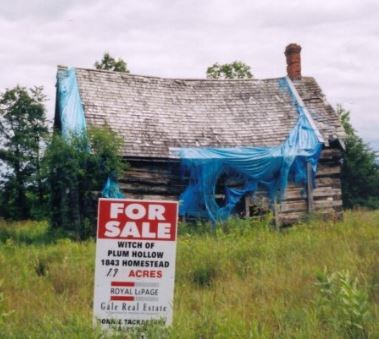
Eloda Wachsmuth, of Navan, Ontario, purchased the cabin in 2005, and invested $35,000 to restore the home, using much of the original logs and lumber in the restoration. Eloda wanted to preserve the history of Jane Barnes, so that she would be remembered.

By the fall of 2007, the cabin was restored, and it was Eloda’s intention that it would be open to the public, so they could learn about Jane Barnes and her years spent as a well-known fortune-teller.
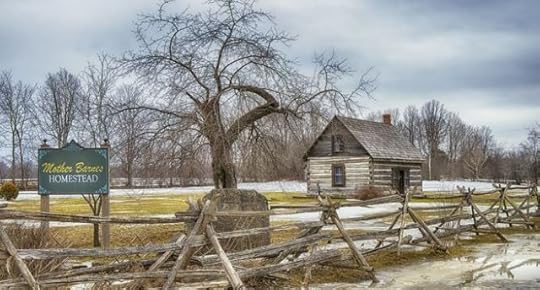
Mother Barnes, as she was affectionately referred to in Leeds, lived a long life, and passed away, at the age of 90, in that same little cabin, where she had shared her predictions over the years.


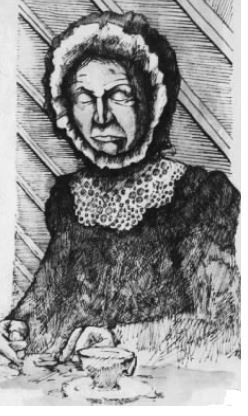
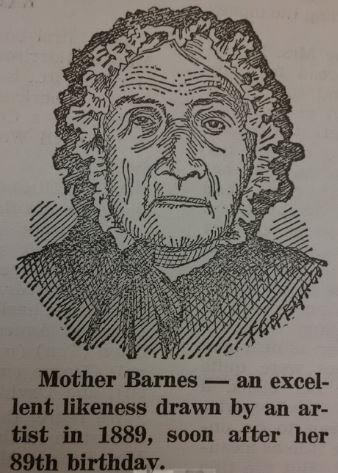
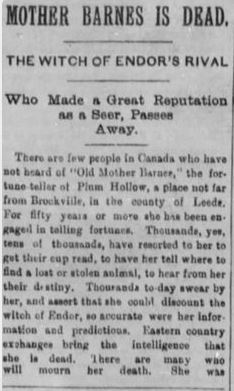
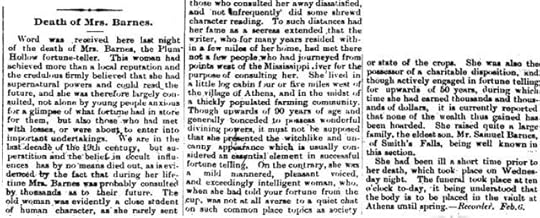

Jane is buried at the Sheldon Cemetery
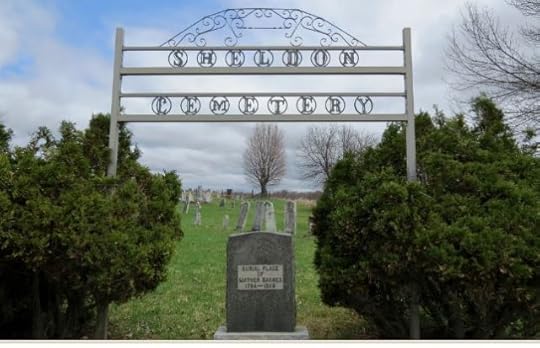
When Jane passed, she was buried in an unmarked grave.
Plum Hollow cheese-makers from 1924-1974, Claude and Ella Flood, erected a stone in memory of ‘Mother Barnes’. (note: the dates on the stone are incorrect)
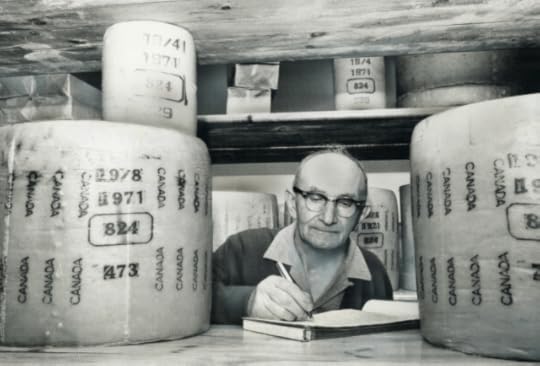

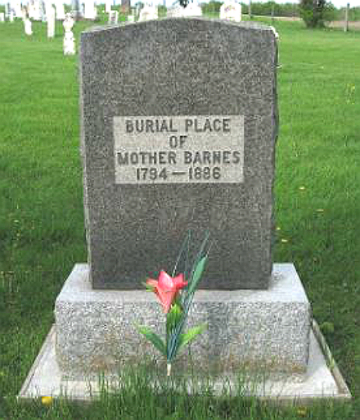
Robert J. Harrison Jr. 1829-
John Barnes 1831-1832
Margaret Barnes 1832-1891
Thomas Barnes 1833-1857
Lucy Barnes 1836-1929
Samuel Barnes 1837-1922
David Barnes 1840-1923
Williston Barnes 1845-1920
George Barnes 1846-1906
Jane ‘Janie’ Barnes 1847-1910
Bella Sheldon 1853-1935
Descendants of Mother Barnes:Jane had a large family, including three adopted children.
Her son David Barnes died in infancy, age 1, and her son Thomas Barnes lived only until age 24.
Her eldest daughter, Margaret ‘Maggie’ Barnes, at the age of 52, married James Robinson.
Her daughter, Lucy Barnes married Metcalfe Peer, Joseph Haskin, and Alva Brown
Her son, Samuel Martin Barnes married Agnes Chalmers
Her son, David Barnes married Fannie Ryel
Her son, Williston ‘Ton’ Barnes, married Lydia Compo
Her son, George W. Barnes married Clarissa ‘Clara’ Kio
Her daughter, Jane, married Charles Wing
Other surnames in ‘Mother’ Barnes family: Bell, Joynt, Cooper, Goodwin, Williams, Buchanan
………………………………….
Discover the fascinating story of Jane Barnes, and her years as a local fortune-teller. Find out about some of Jane’s most prominent and famous customers. Who were the high-profile movers and shakers who sought Jane’s advice on a regular basis? Read about a grisly murder case that perplexed police, and was finally solved by Jane. Who was the famous and controversial newspaper publisher who sent his wife to ask Jane’s predictions because he didn’t want to be seen visiting a ‘fortune-teller’. Learn about the case of a poltergeist in Quebec, where the family seeks Jane’s help in solving the violent and frightening haunting of their house. Discover these stories and more, in the book:“Lanark County Calling: All Roads Lead Home”, the complete story of Jane Barnes, a gifted lady, also known as – ‘The Witch of Plum Hollow” ISBN 978-0-987-702661 – at The Book Nook, in Perth, ON 613-267-2350.Arlene Stafford-Wilson
Honorary Life Member, Lanark County Genealogical Society
Member, Association of Professional Genealogists
Author of : “Lanark County Christmas”, “Lanark County Comfort”, “Lanark County Collection”, “Lanark County Calling”, “Lanark County Classics”, “Lanark County Connections”, “Lanark County Calendar”, “Lanark County Chronicle”, “Lanark County Kid”, & “Recipes & Recollections”
October 1, 2023
Photos – Book Launch “Lanark County Kitchen”
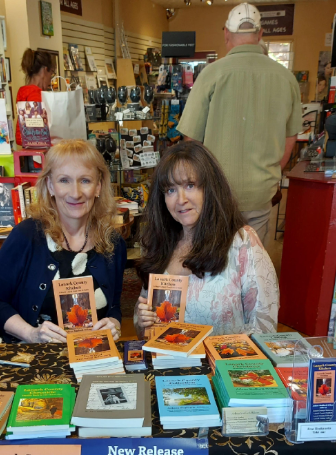
The warm temperatures, and bright sunshine brought a steady stream of visitors to The Book Nook, in Perth, Ontario, at the book launch for, “Lanark County Kitchen: A Maple Legacy from Tree to Table”.
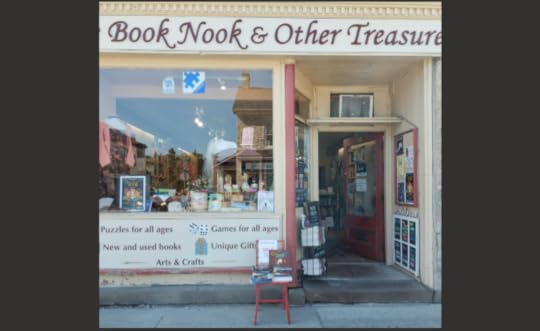
One of the heritage maple families featured in the book, the Temple family, below:

Susan Snyder and Charlie Temple are celebrating 50 years at Temple’s Maple, in Ferguson Falls. Their beautiful pancake restaurant and wedding venue, is located on the property formerly owned by the McEwen family, and McEwen’s Pancake House. It’s always nice to chat with long-time maple syrup producers, and learn the secrets to making award-winning syrup. One of the recipes from their popular pancake restaurant is featured in the book.
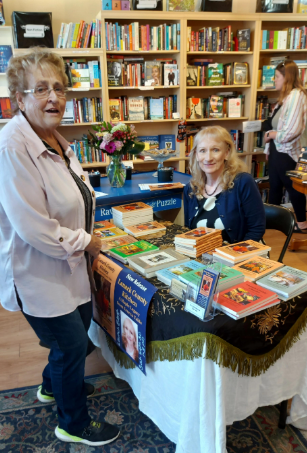
It’s always a treat to visit with Doris Quinn, long-time Ferguson Falls historian.
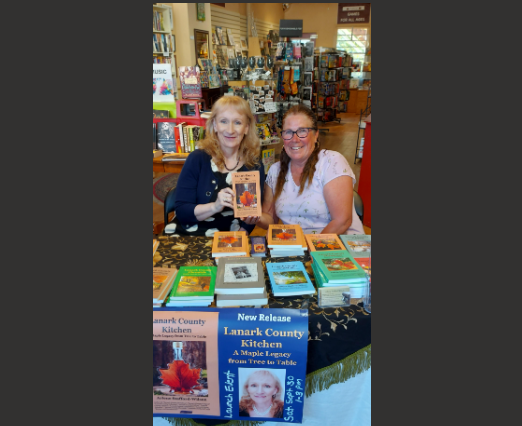
It was fun chatting with Sue, and learning that she has read almost all of the books.
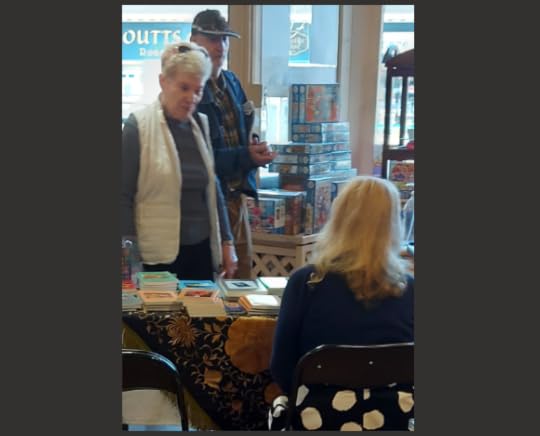
Always a pleasure to see Vivan Young, genealogist, and sister of Tressa Oliver.
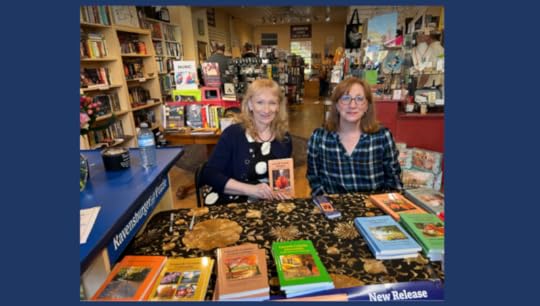
It was great chatting with Tressa Oliver. The Oliver family has been producing maple sugar and maple syrup on their property since 1827. David Oliver is an arborist by trade, and so he is an ideal caretaker of their family’s venerable old sugar bush.
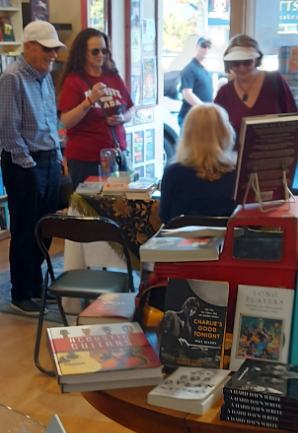
A visit from the Miller family was a nice surprise. The Miller’s are descendants of the Andrew Miller family of Bathurst Township who built the handsome red brick house on the Third Line. This was purchased by members of the Stafford family in 1936, (Thomas and Clara Carberry) and then sold to our parents in 1946, when they returned after the war. This charming home remained in our family for many, many, decades. Many of the stories in the books are set in this property and surrounding area. It’s a place that truly has been an inspiration.
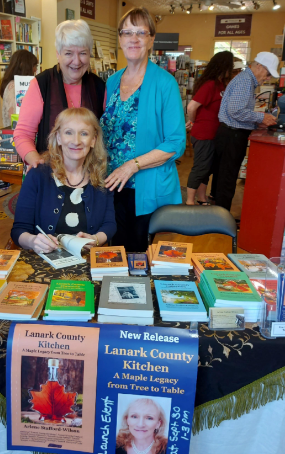
It’s always a pleasure to visit with friends, Margery Conboy and Bev Ferlatte. Former neighbours and long-time members of Calvin United Church, DeWitt’s Corners.

It was a great surprise to meet and have a chance to visit with the McGarry sisters, Mary and Karen. They are descendants of the McGarry family, who arrived in Drummond Township in 1816, from County Westmeath, Ireland, John McGarry and Mary Tone.

The McGarry family married into the Stafford family in 1824, in Perth – Tobias Stafford and Elizabeth McGarry.
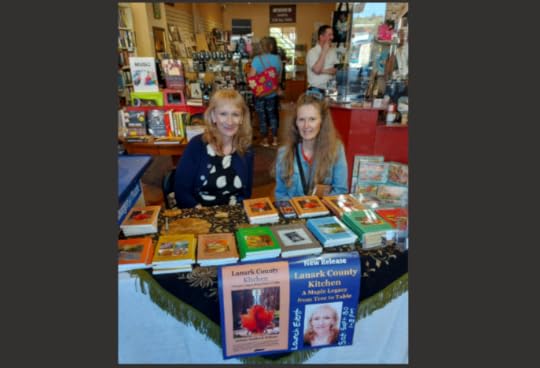
I enjoyed chatting with Carol Ritchie, a direct descendant of the Ritchie family who were the original settlers on the site of what is now known as ‘Eco-Tay’. The Ritchie family has a long and storied history in Tay Valley Township.
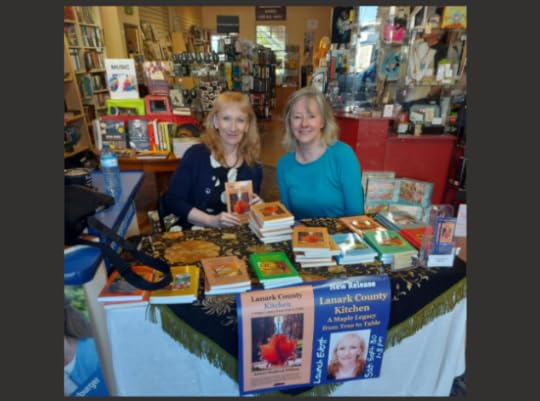
It’s always great connecting with readers, and discussing previous books, as well as the new one.
Thanks to Leslie Wallack, and The Book Nook for hosting the book launch of, “Lanark County Kitchen: A Maple Legacy from Tree to Table”. Thank-you for providing the delicious snacks, and the lovely floral arrangement, and for making our day special.
A special thank-you to all who came to the launch. It was great seeing old friends, and meeting new ones. What an incredible day – busy from start to finish.
Many thanks again to the legacy maple families for sharing the history and stories of their maple operations from the times of the early settlers, and the evolution of methods and equipment to their modern-day maple syrup harvest. Thanks also for sharing old family recipes, some passed down through the generations, and some from their own popular pancake restaurants.
Lloyd Cameron, Brenda (Chaplin) Gutoske, Gordon Chaplin, Margery Conboy, Wayne Conboy, Diana Coutts, Ron Coutts, Stephen Dodds, Karen (Stead) Ennis, Marty Ennis, Jamie Fortune, Ray Fortune, Shirley Fulton-Deugo, Dwight James, Tom McEwen, Bill McEwen, David Oliver, Tressa Oliver, Darrell Paul, Susan Snyder, Charlie Temple, Leann Thompson, Ray Thompson, Rosetta (Van Alstine) McInnes, Judy Wheeler, Tracy Wheeler, and Vernon Wheeler.
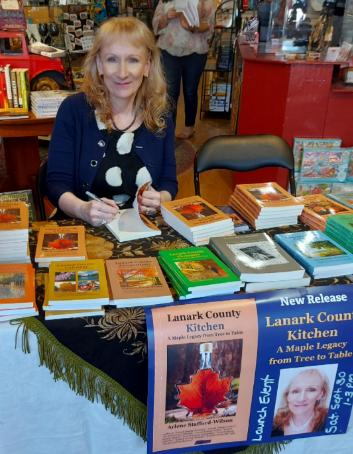
Arlene Stafford-Wilson
Honorary Life Member, Lanark County Genealogical Society
Member, Association of Professional Genealogists
Author of : “Lanark County Christmas”, “Lanark County Comfort”, “Lanark County Collection”, “Lanark County Calling”, “Lanark County Classics”, “Lanark County Connections”, “Lanark County Calendar”, “Lanark County Chronicle”, “Lanark County Kid”, & “Recipes & Recollections”
September 29, 2023
Irish Feast of Michael – September 29th
Celebrating St. Michael’s Day, on September 29th, is an old Irish custom going back to the earliest times of the Celts. It was the day to mark the end of the harvest. On this day each year farmers would count their animals and decide how many they could afford to keep and feed over the long winter ahead, and how many would have to be sold and sent to slaughter. It was also a tribute to honour the three archangels, Angel Michael, Angel Gabriel, and Angel Raphael.
The Autumn Wind blows open the gate
St. Michael for you we wait
We follow you, show us the way
With joy we greet this Autumn day
Good Morning, Good Morning, Good Morning!

Michaelmas, (pronounced “mick-el-miss”) or St. Michael’s Day, was also a day for traditional county fairs, and of job fairs, where farmers could hire winter labour, after the end of the harvest. Families gathered and spent the day together and then shared a feast of freshly baked bread, roast goose, potatoes, and a glass or two of beer or whiskey.

St. Michael’s Day marked the end of the fishing season, and the beginning of the hunting season, and a traditional goose dinner was served in Irish homes to mark the occasion. In many parts of Ireland, farmers gave gifts of geese to the poor, and they also sold their down and feathers on that day at the local fairs, to be used for mattresses and pillows.

Michaelmas Pie
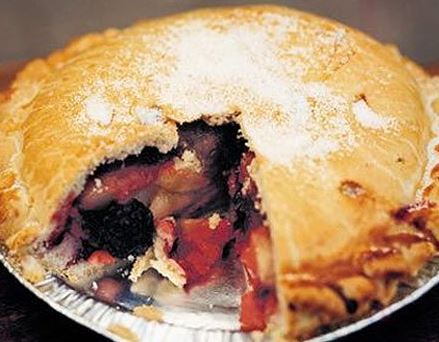
It was a custom to bake a Michaelmas pie, and to hide a ring in the pie. Whoever got the piece with the ring would be married within the year. The pies were made with apples and blackberries, which were ripe and delicious in late September. According to old Irish folklore, at Michaelmas, the devil spits on the blackberries after September 29th, so that is the last day to eat them safely. Irish legends say, when St. Michael cast Satan from Heaven, the devil landed on the Earth in a patch of blackberry brambles and he returns each year to spit on the plant that tortured him.
Goose for the Feast
During the Middle Ages, St. Michael’s Day was a religious feast in most of western Europe, celebrating the end of the harvest. It was the custom to eat a goose on Michaelmas, and legend tells that this ritual was supposed to protect against financial need for the next year.
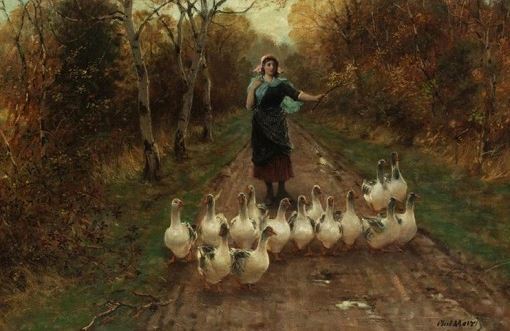
“He who eats goose on Michaelmas Day
shan’t money lack or debts to pay”

Predicting the
Winter Weather
The roasted goose was supposed to be eaten up by midnight on September 30th, and the breastbone was used to foretell the weather for the coming winter by holding it up to the light. A translucent breastbone meant that the winter ahead would be mild, while a thick cloudy breastbone meant it would be a long cold winter.
Potatoes and carrots were roasted in the goose fat, and a slice or two of Irish soda bread was served with the meal. Toasts were made to St. Michael, with Irish whiskey.

Recipe for Michaelmas Pie
INGREDIENTS
12 oz plain flour, sifted
1/2 tsp ground cinnamon
3 oz lard
3 oz chilled butter, diced
3 fl oz chilled water
pinch salt
2 lbs cooking apples
2 oz sugar
1 tsp ground cloves
1 tsp ground nutmeg
12 oz blackberries
1 egg, beaten
DIRECTIONS
Pre-heat the oven to 350 F.
Prepare the pastry. Place the flour in a mixing bowl and stir in the cinnamon and salt. Rub in the butter and lard until the mixture resembles fine breadcrumbs. Form a well in the centre and add the water. Mix together using a wire pastry blender, then knead briefly, and place in a plastic bag in the fridge. Leave to rest for 30 minutes.
Peel and core the apples. Cut them and place them in a saucepan with the sugar, cloves and nutmeg. Cover with a lid and gently simmer for 5 minutes, until the apples have softened. Next, fold in the blackberries and remove the saucepan from the heat. Cool the mixture.
Take pastry from the fridge and roll out two thirds on a lightly floured surface. Line an 8-inch metal pie plate. Pierce the base of the pastry with a fork. Strain the fruit, and spoon the fruit mixture over. Roll out the remaining pastry and lay the pastry over the fruit. Brush the base with a little egg and seal the edge. Trim and crimp the edges. Brush the surface with the remaining egg and with a knife make slits in the top. Bake for 35 minutes. Serve hot or cold with vanilla ice cream or fresh whipped cream.

Is there a ‘Michael’
in your family?
The devotion to St. Michael in Ireland was so great, that at one time almost every family had a child named Michael. In 1923, Michael was the most popular name for boys in Ireland. In Catholic households, families with no boys would often give the name ‘Michael’ as a middle name for their daughters. At one time, it was not unusual for nuns to have the name of Sister Michael.

St. Michael is the Patron Saint of grocers, soldiers, doctors, mariners, paratroopers, and police, and it’s his responsibility to escort the faithful to heaven at their hour of death. He is known as the protector of humanity, who inspires the qualities of courage, initiative and steadfastness.
Irish Ancestry
For those with Irish heritage, September 29th, or St. Michael’s Day, is a day that we may choose to observe some of the old ways of our ancestors. In North America we might cook a chicken instead of a goose, and may substitute with blueberries or raspberries in our Michaelmas pies.
Whether we celebrate with a traditional Michaelmas feast on September 29th, or just have a wee shot of whiskey and a toast to St. Michael, it’s a day to pause for a moment and remember our ancestors, and how they marked the end of the harvest, and the beginning of a new season.

Slainte! “To Your Health!”
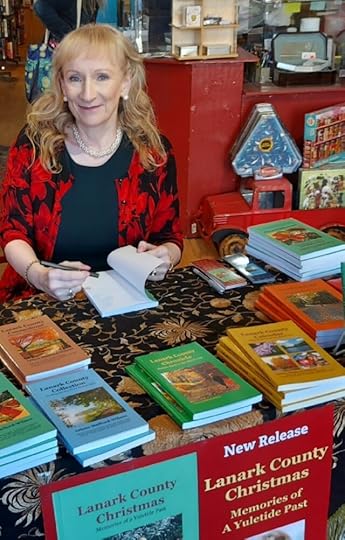
Arlene Stafford-Wilson
Honorary Life Member, Lanark County Genealogical Society
Member, Association of Professional Genealogists
Author of : “Lanark County Christmas”, “Lanark County Comfort”, “Lanark County Collection”, “Lanark County Calling”, “Lanark County Classics”, “Lanark County Connections”, “Lanark County Calendar”, “Lanark County Chronicle”, “Lanark County Kid”, & “Recipes & Recollections”
September 28, 2023
Inside Ottawa Valley reviews “Lanark County Kitchen”
*

*
*

*

*

*
*
*
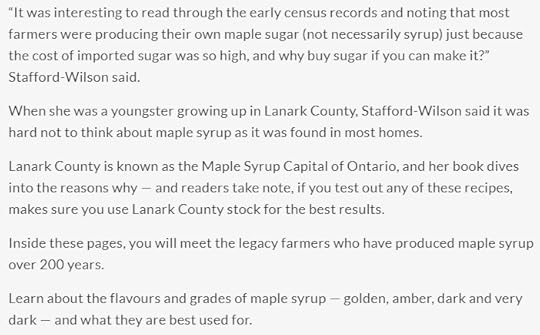
*
*
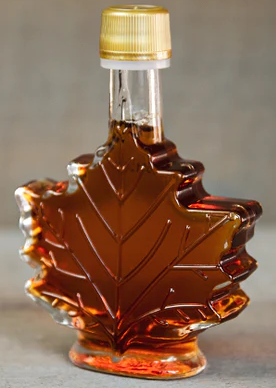
*
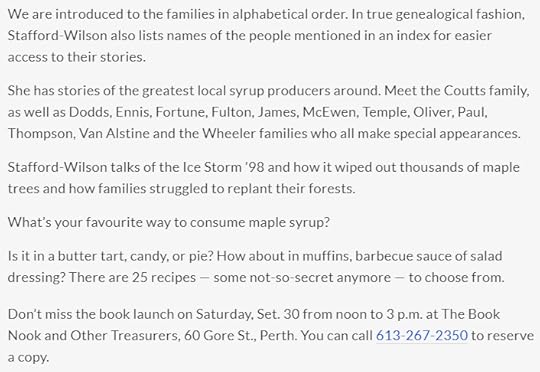
*
*
To reserve a copy from The Book Nook:
Lanark County Kitchen: a Maple legacy from tree to table – Arlene Stafford Wilson – BOOK LAUNCH September 30, 12-3 pm * reserve your copy in a preorderAuthor of 11 books set in Lanark County, Ontario –

Arlene Stafford-Wilson
Honorary Life Member, Lanark County Genealogical Society
Member, Association of Professional Genealogists
Author of : “Lanark County Christmas”, “Lanark County Comfort”, “Lanark County Collection”, “Lanark County Calling”, “Lanark County Classics”, “Lanark County Connections”, “Lanark County Calendar”, “Lanark County Chronicle”, “Lanark County Kid”, & “Recipes & Recollections”

